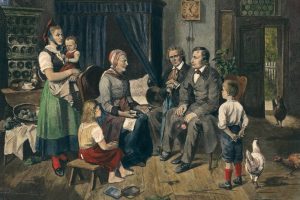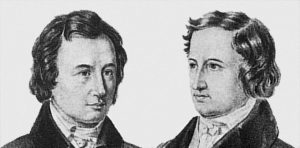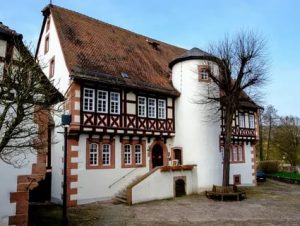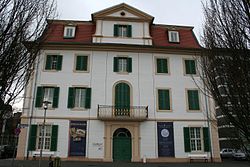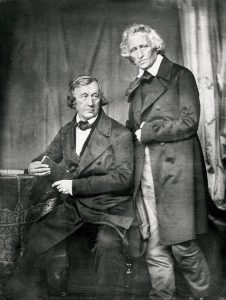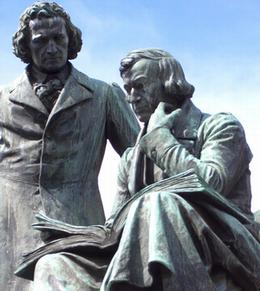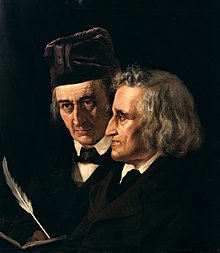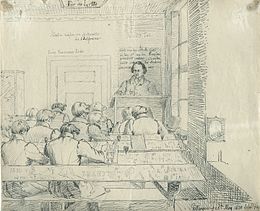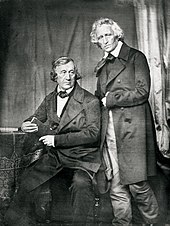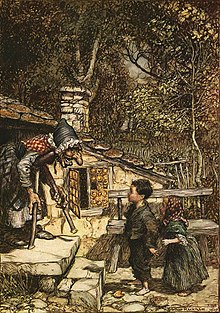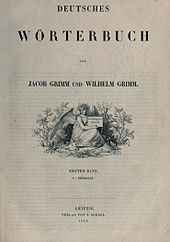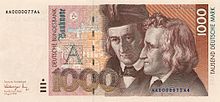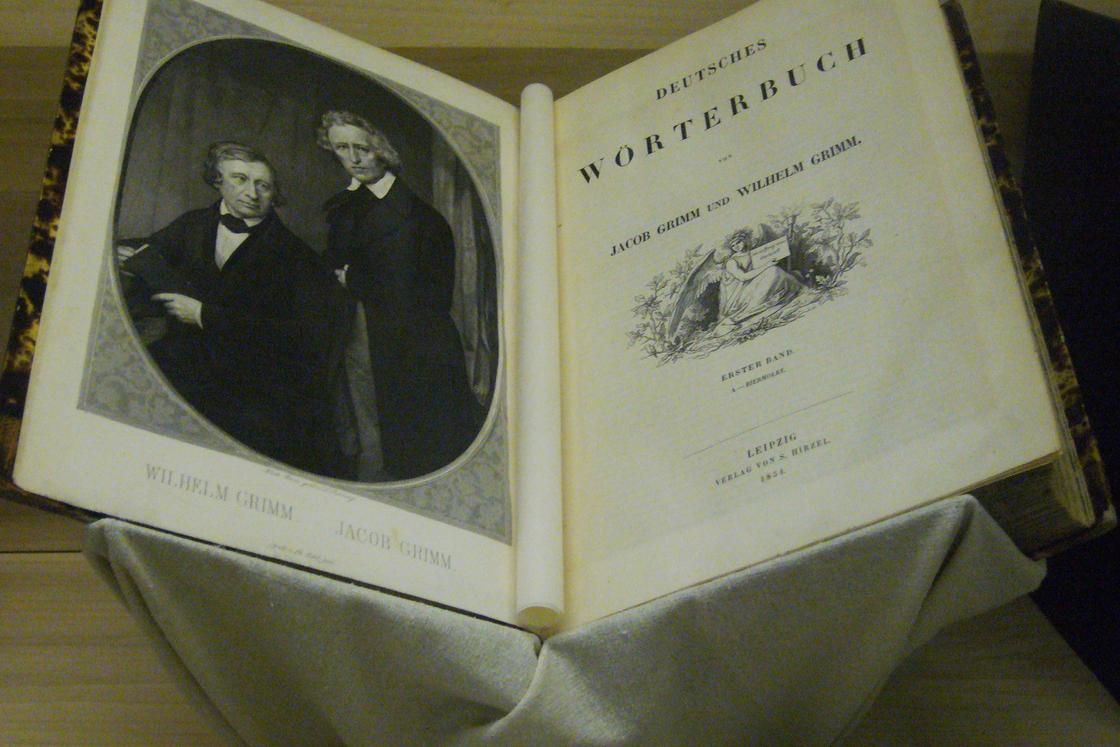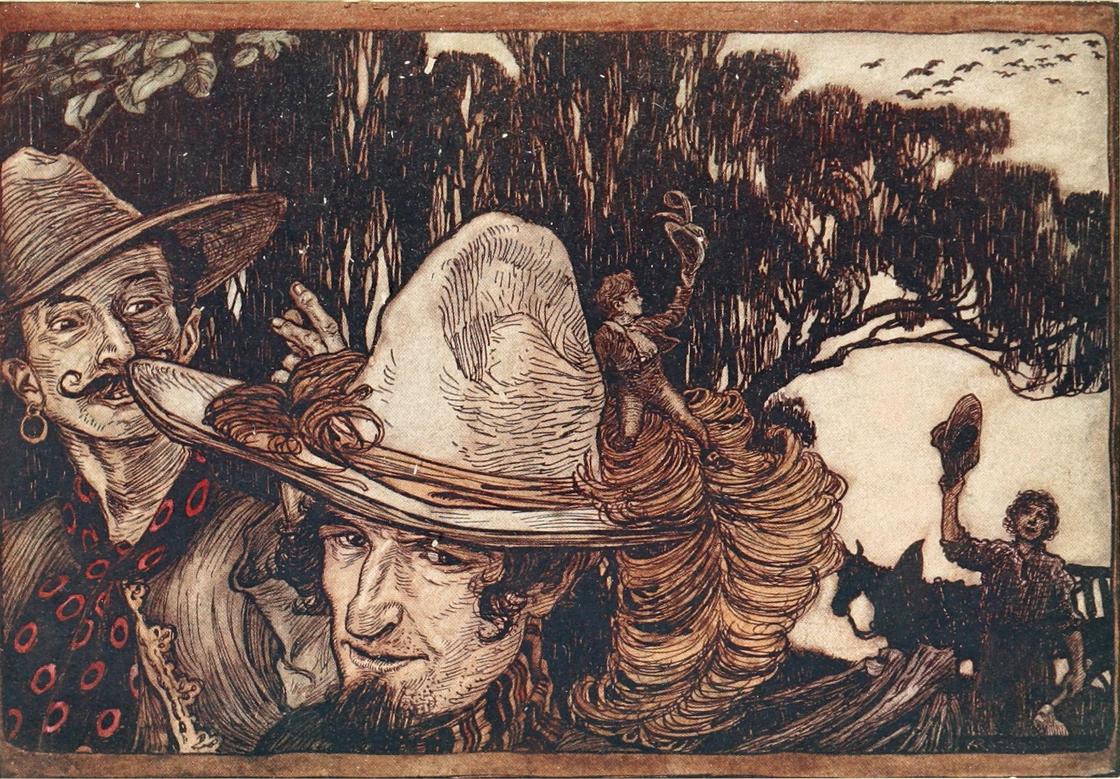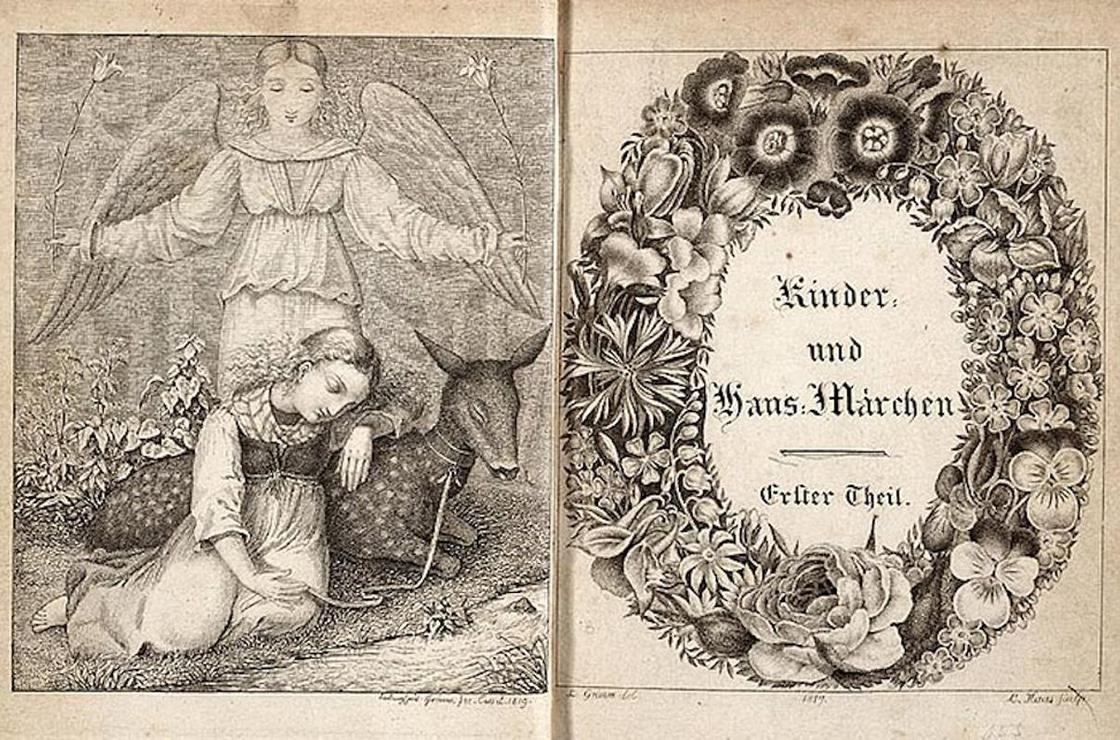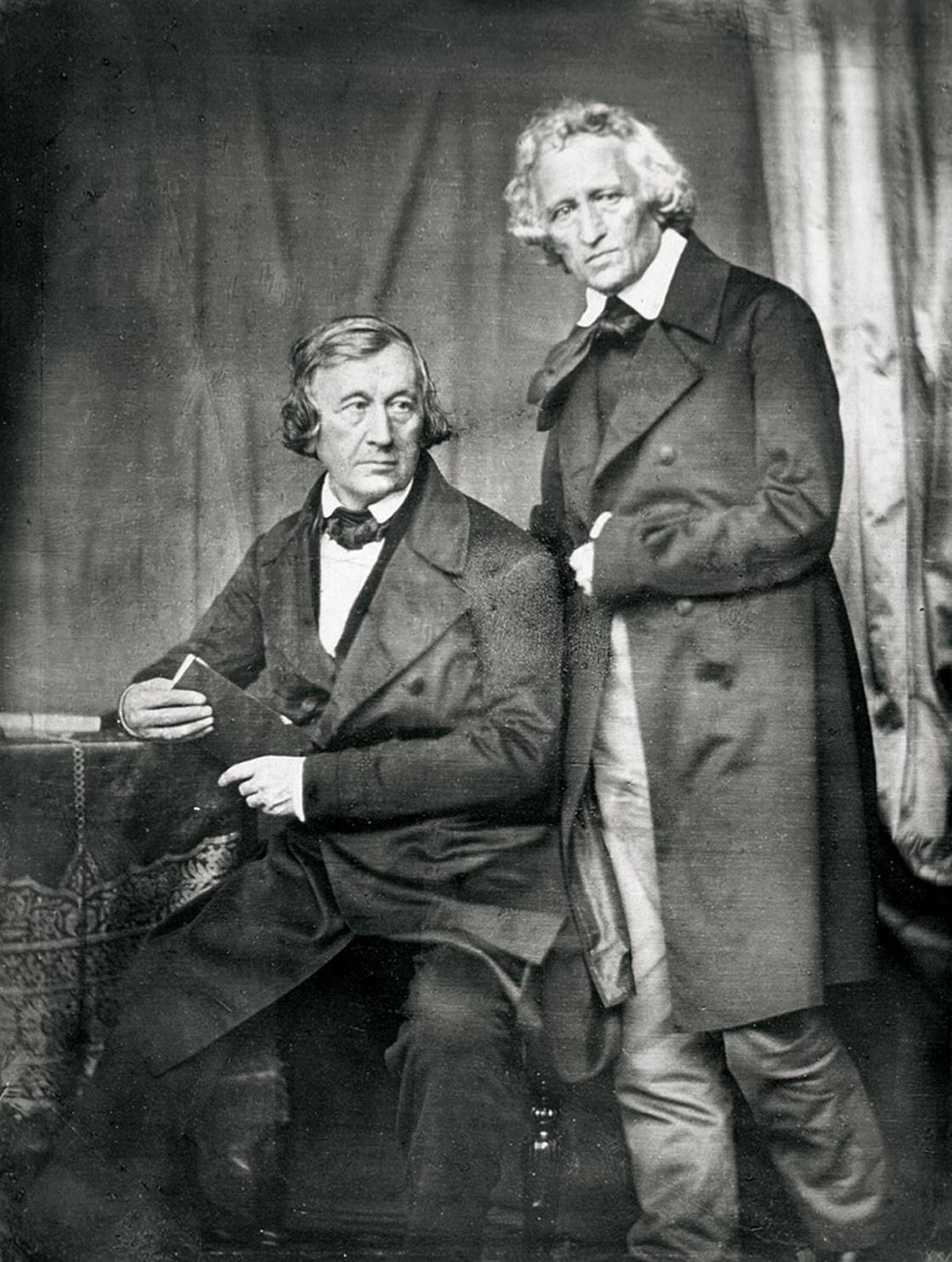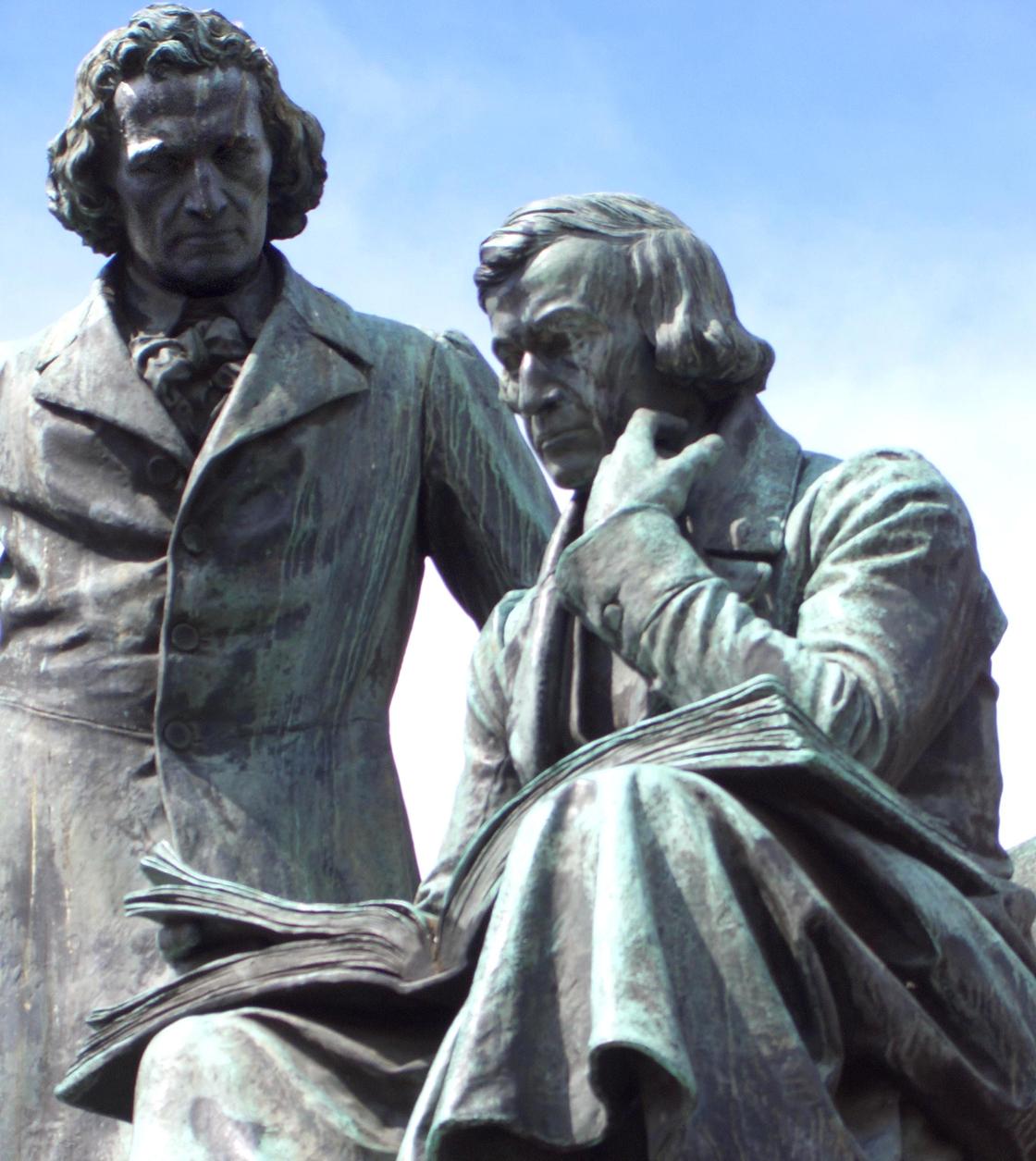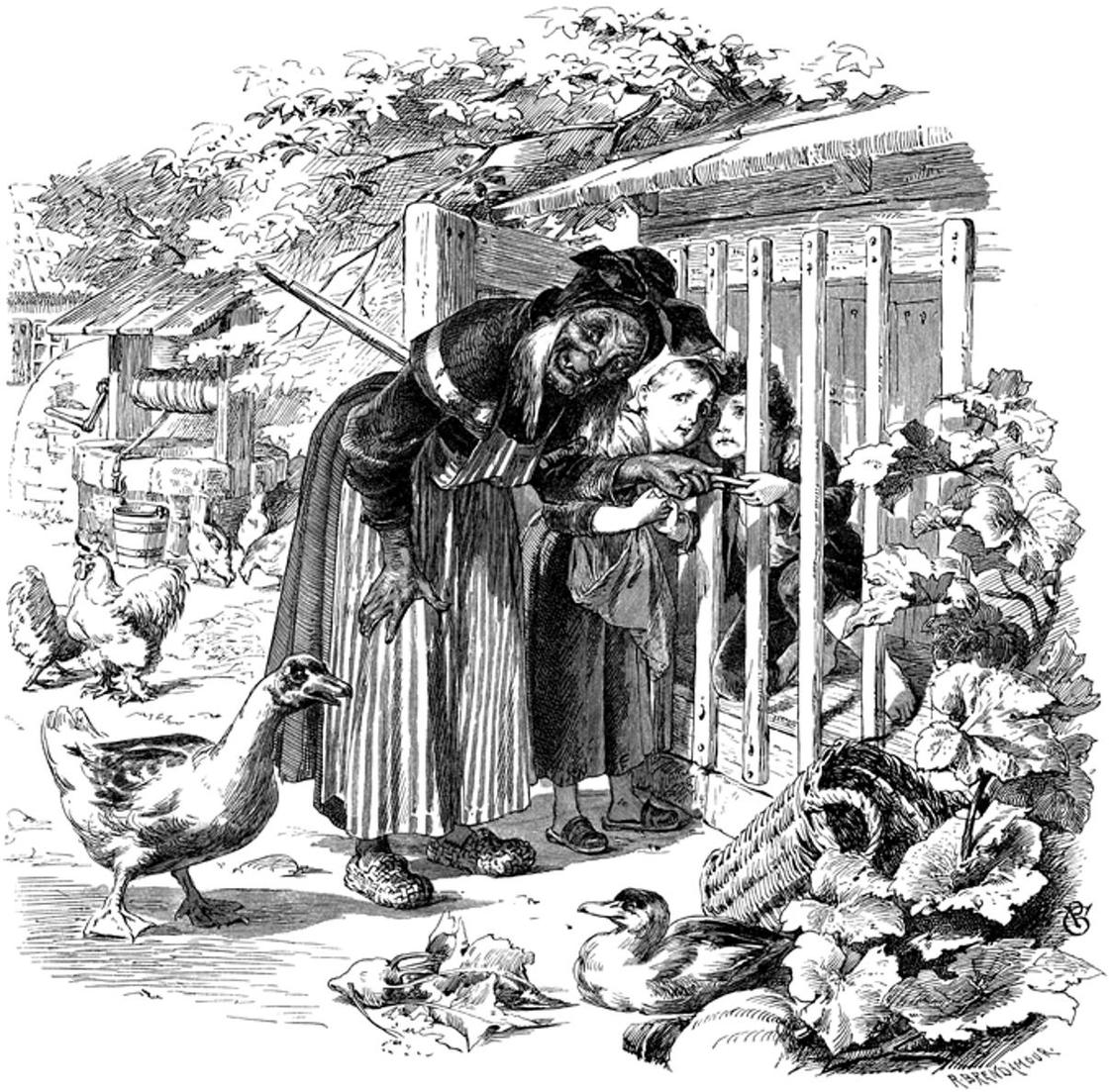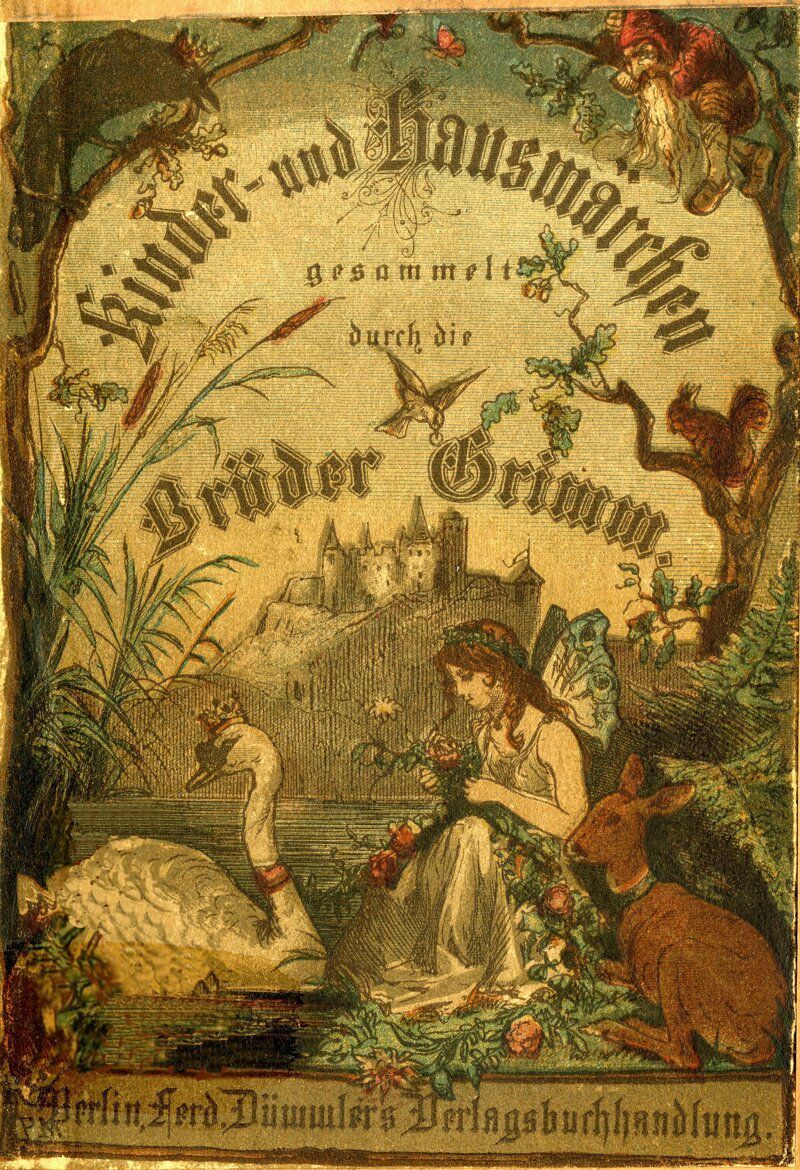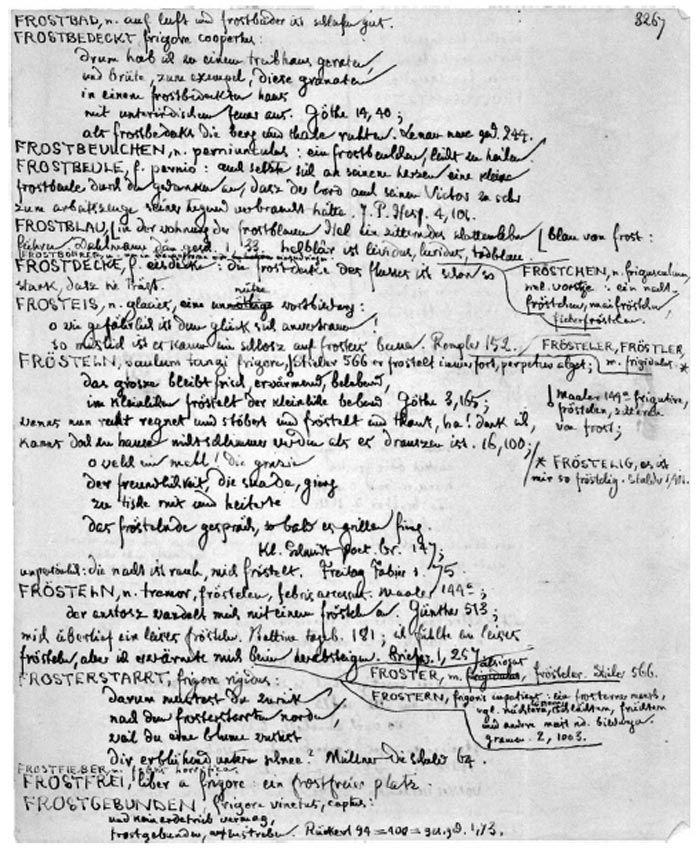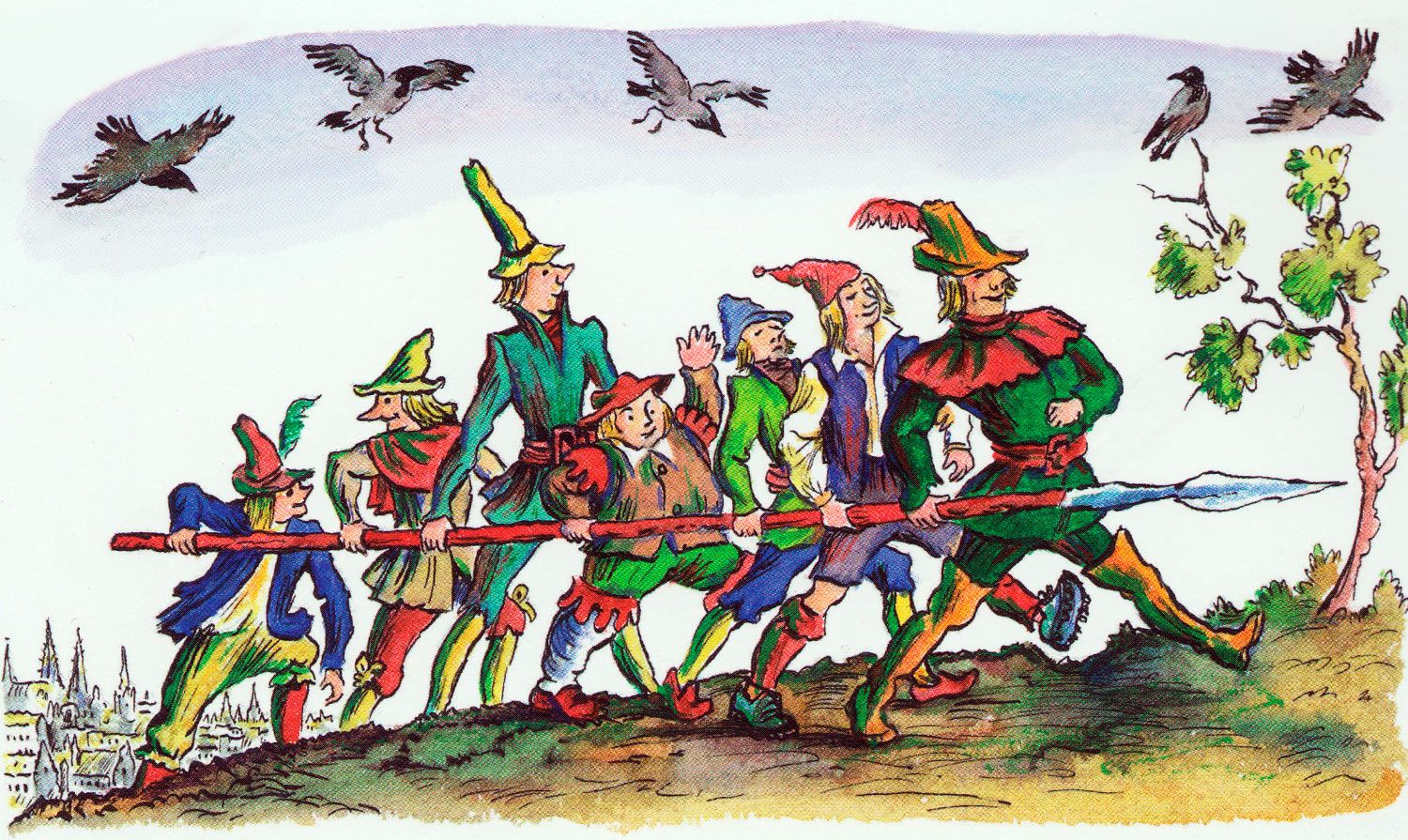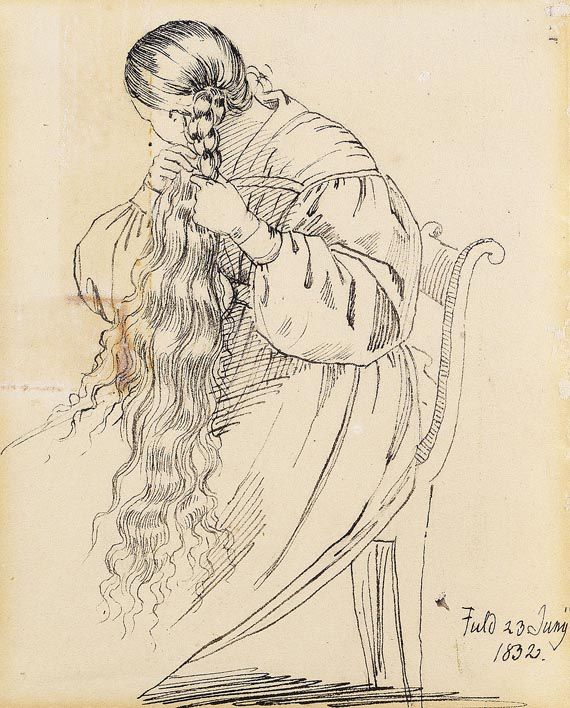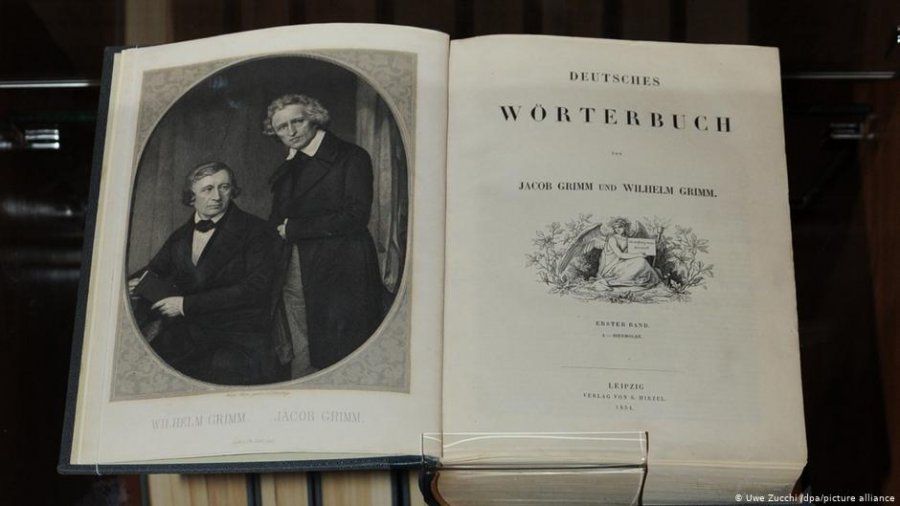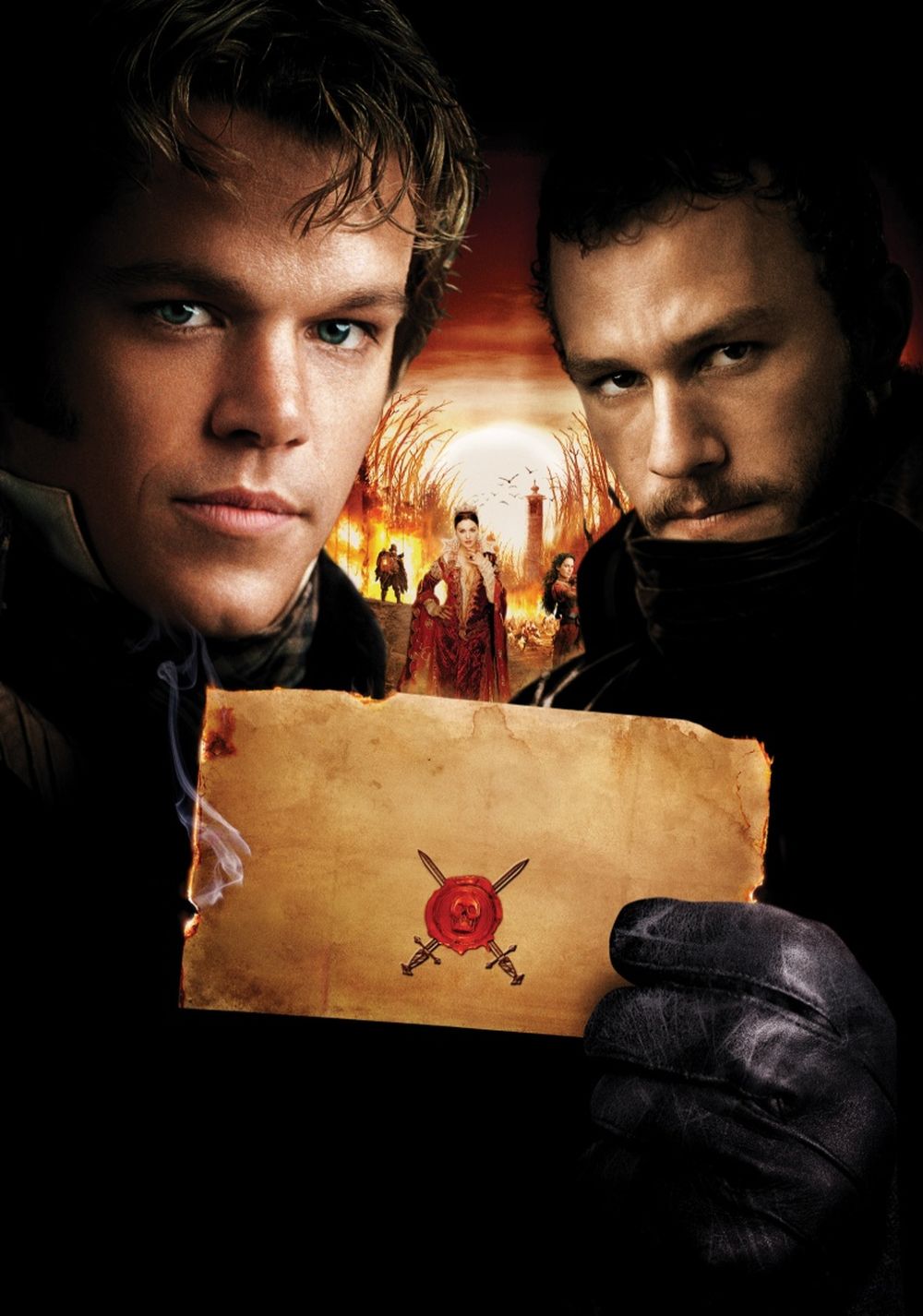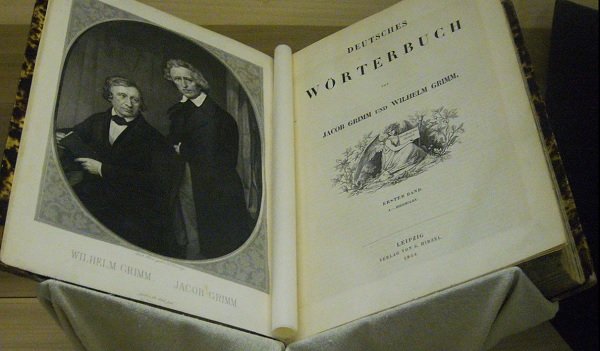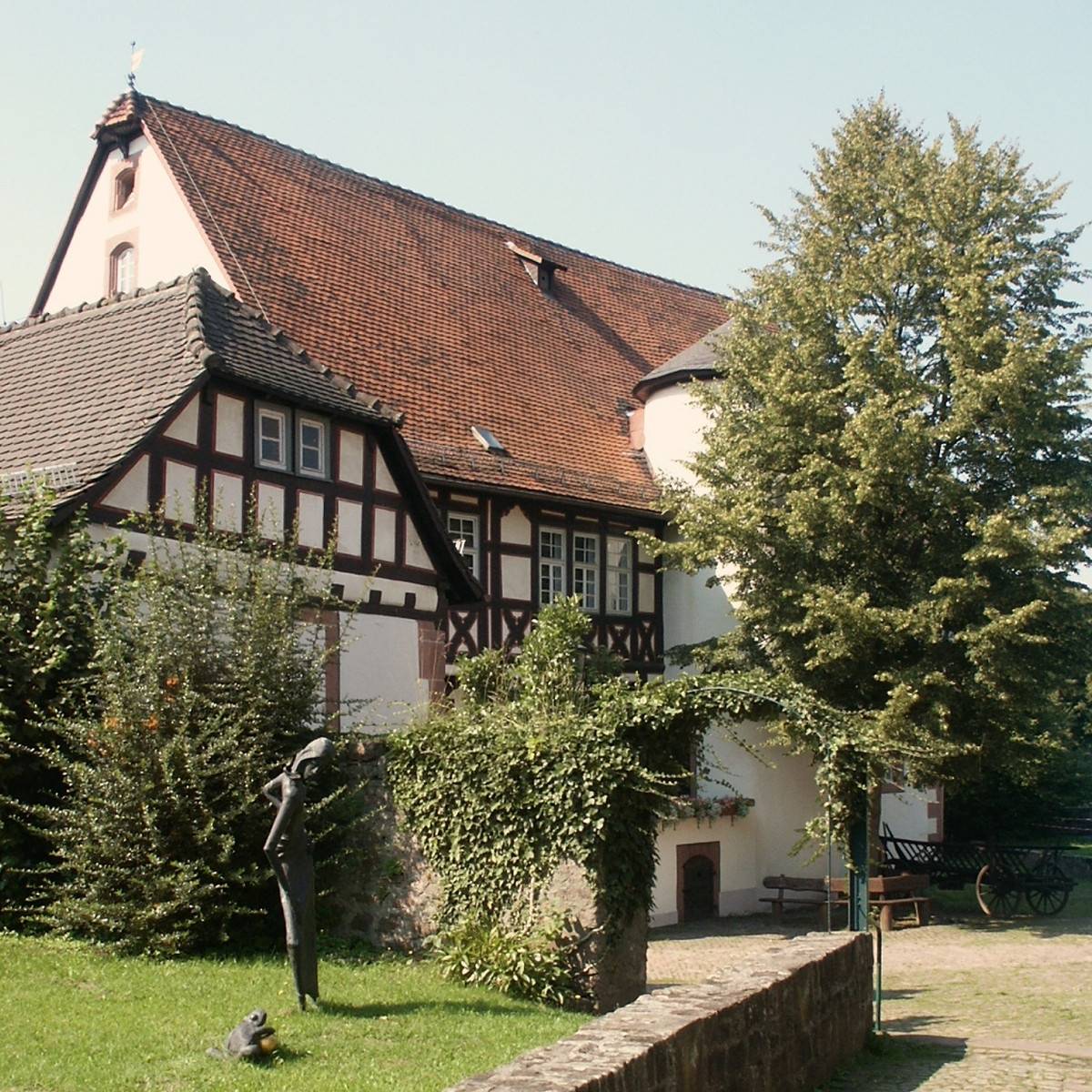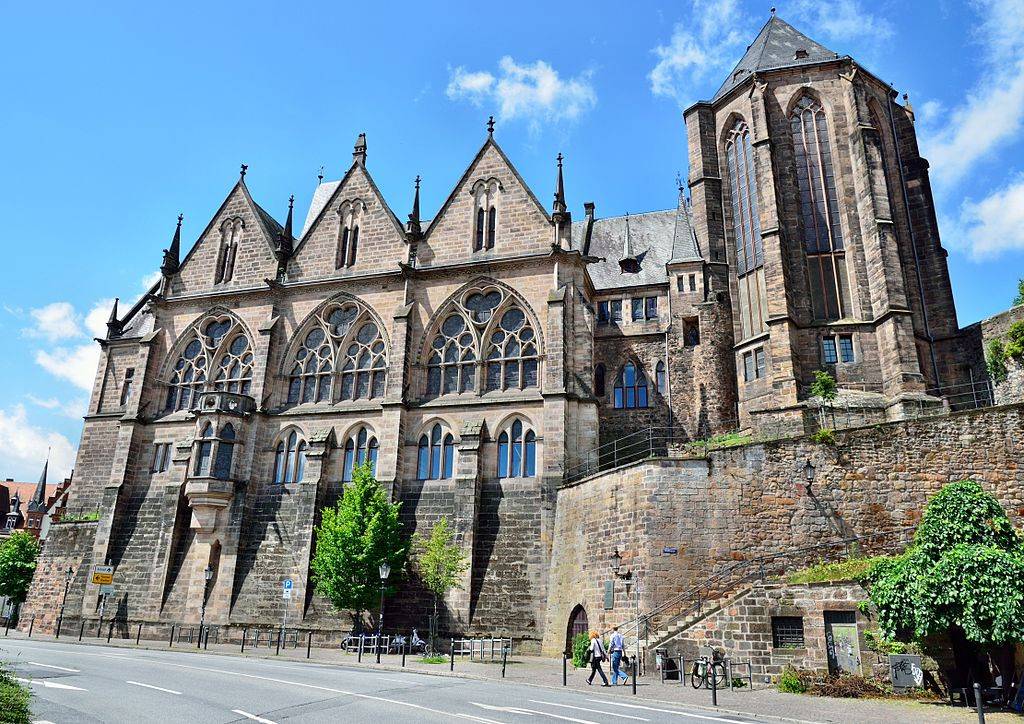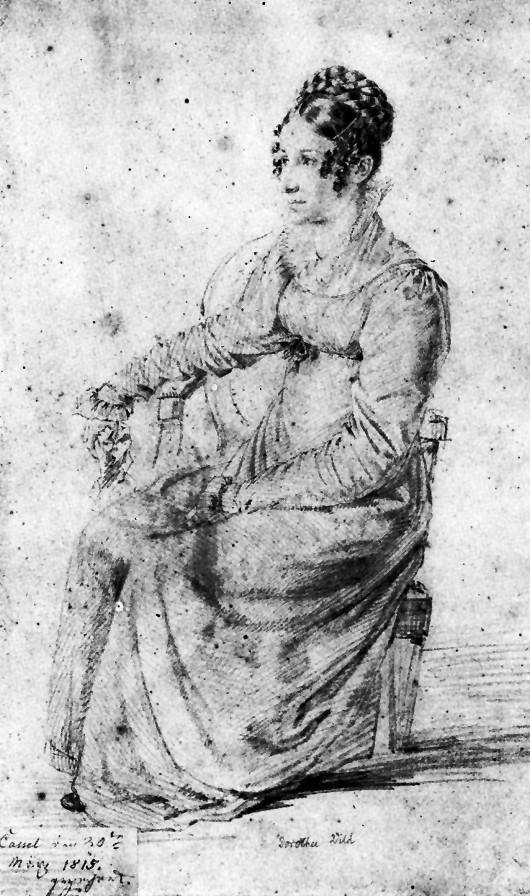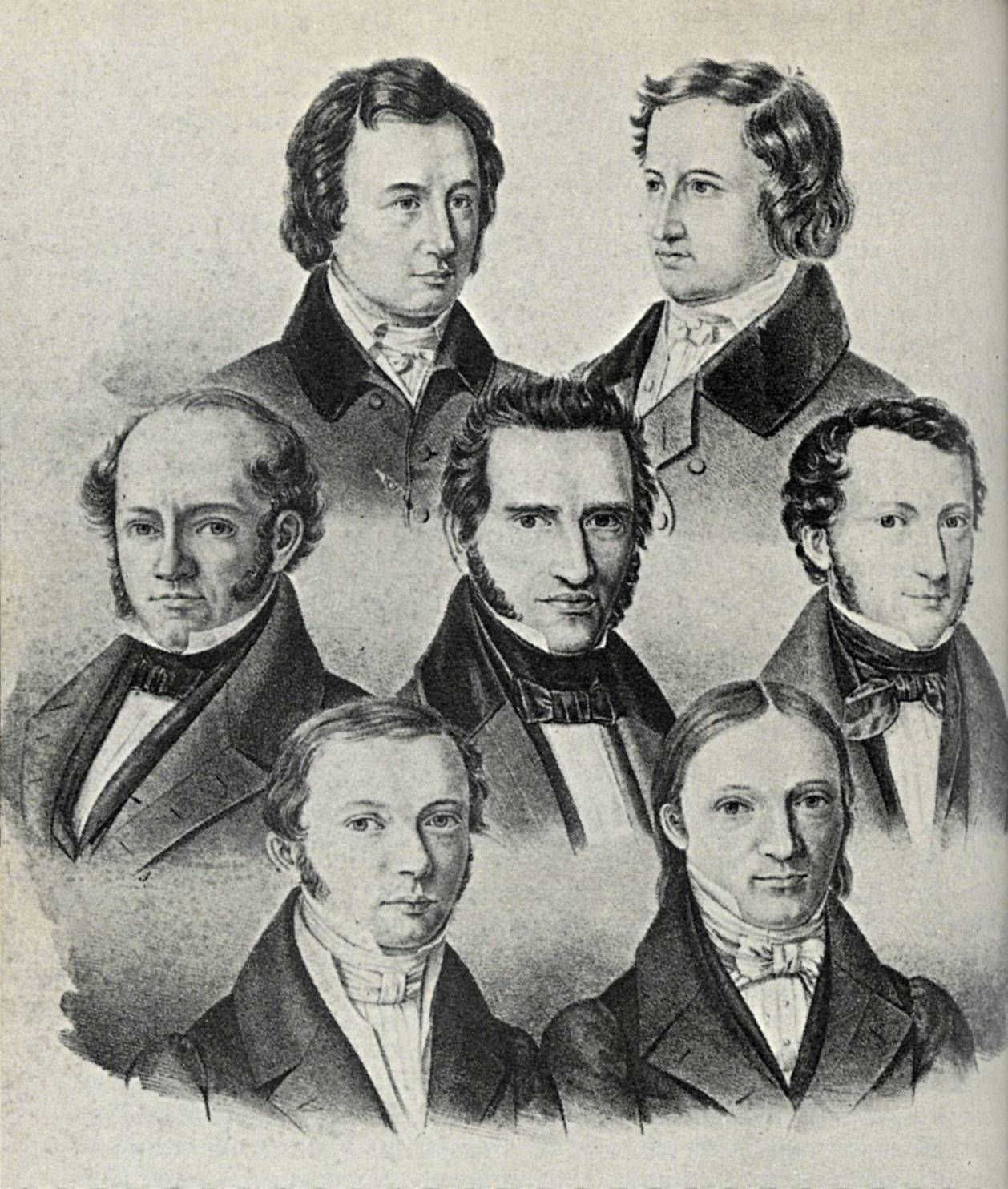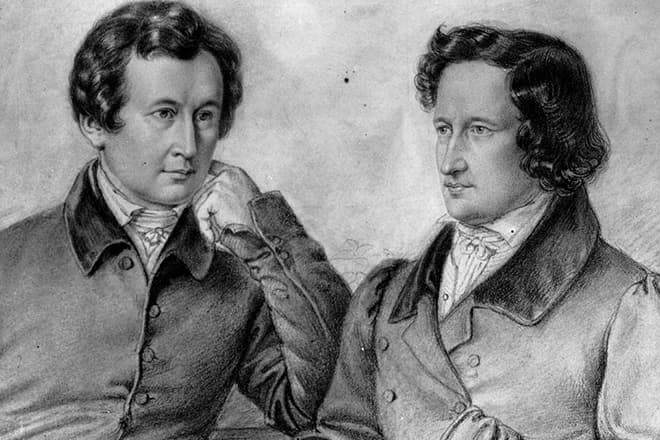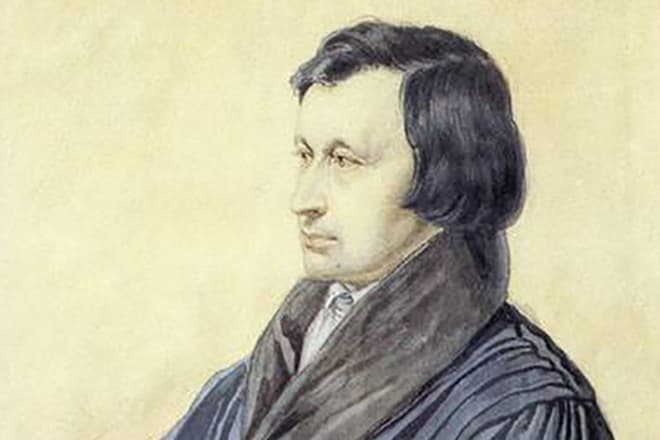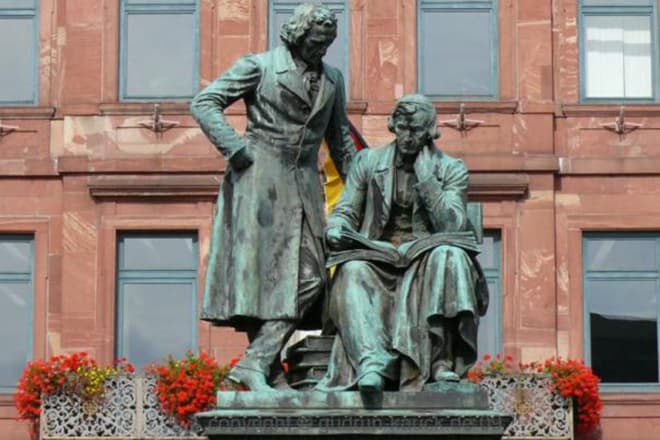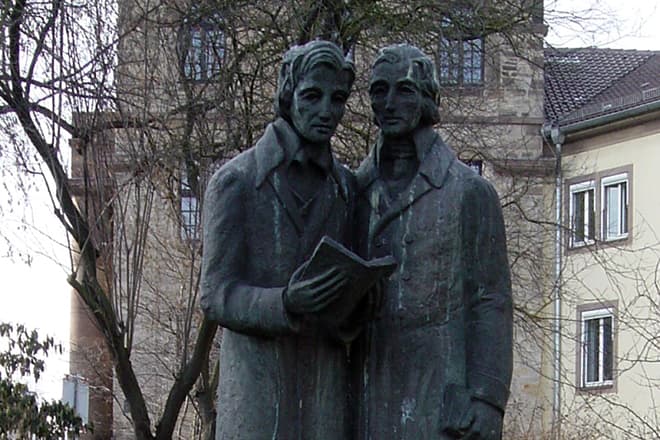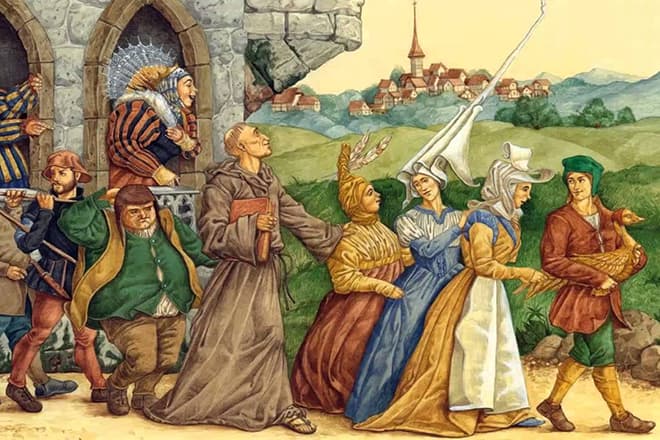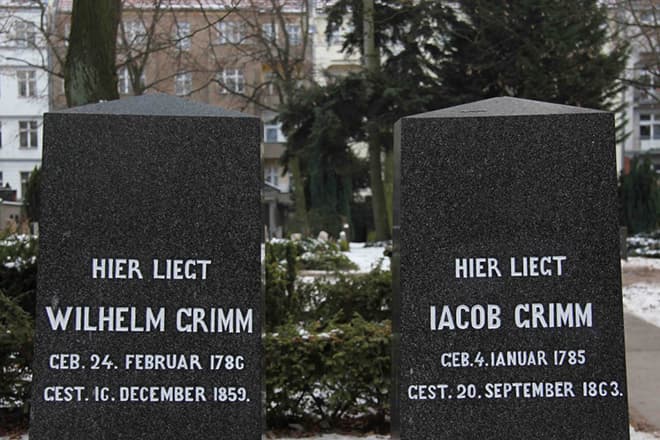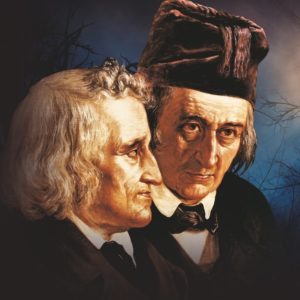 Роль и место в литературе
Роль и место в литературе
Выдающиеся ученые, филологи Братья Гримм внесли огромный вклад в исследование устного народного творчества и развитие немецкого языка. Они очень трепетно относились к тому, чтобы сказки доходили до читателя в первозданном виде, без каких-либо искажений или современных переработок.
Особой скрупулезностью отличался Якоб, который призывал строго соблюдать фольклорную точность. В противовес ему, Вильгельм, который был больше литератором, чем ученым, утверждал, что необходима обработка текста. Такие расхождения во взглядах оказались весьма полезными: мир увидел произведения, в которых органично был совмещен оригинальный стиль с научной достоверностью.
Братья вовсе не стремились дословно сохранять стиль рассказчиков. Неприкосновенными оставались композиция, сюжет сказки, порядок повествования и ее дух. Стиль же они выработали свой собственный, который отличался искренностью, простотой, нередко лукавостью. Именно благодаря такому подходу сборники их сказок представляли собой совершенно уникальное явление в немецкой литературе.
Семья Гримм
Происхождение и ранние годы
Старший из братьев, Якоб Людвиг Карл, родился 4 января 1785 года в городе Ханау. Через год, 24 февраля 1786 года появился на свет его младший брат Вильгельм Карл. Оба брата родились в Германии и были старшими сыновьями главы большого семейства, Филиппа Вильгельма. Отец мальчиков занимал должность чиновника в суде и одновременно являлся служителем реформаторской церкви.
Братья в молодости
Через шесть лет после рождения Якоба отец перевез семью в Нижнюю Саксонию, где он стал руководителем одного из округов. В возрасте сорока четырех лет он, простудившись, умер от пневмонии. Вдова, Доротея Гримм, оказалась в катастрофическом положении, теперь ей одной предстояло воспитывать девятерых детей. Финансовую поддержку семье оказала тетя мальчиков, сестра их отца Шарлотта. Спустя какое-то время заболела и она, и Гриммы остались один на один со своими проблемами. Старшие сыновья, чувствуя свою ответственность за благополучие остальных членов семьи, взвалили на себя основную часть обязанностей.
Образование
Мать видела, каким потенциалом обладают ее старшие сыновья, поэтому всеми силами старалась дать им достойное образование. Братья отправились в Кассель, к сестре матери, чтобы под ее присмотром учиться в лицее. Базовыми знаниями, которые включали в себя словесность, философию, физику, естествознание, географию, историю, мальчики овладели на отлично. Окончив лицей за четыре года, что составляло половину полного срока обучения, братья с интервалом в один год стали студентами юридического факультета университета Марбурга.
Дом-музей в Штайнау
В свободное от основных занятий время они занимались изучением литературы, больше всего их интересовала немецкая поэзия. К такой заинтересованности их побудил профессор Фридрих фон Савиньи. У него был свой, оригинальный подход к изучению права с позиции проявления в нем «народной души». Эту идею братья взяли за основу, когда вплотную занялись литературным творчеством. Написанные ими сказки становились отражением души и ума народа Германии.
Творчество
Братья Гримм оставили после себя огромное наследие в виде сказок, но не только это прославило их имена. Им принадлежат исследования, посвященные развитию лексики и грамматики немецкого языка. Их достижения в науке и творчестве неоценимы.
В 1812 году были изданы «Детские и семейные сказки». Это был сборник, в который вошли сто лучших сказок, записанных и художественно обработанных братьями. Второй том вышел через три года, в это время их имена уже были знакомы каждому жителю Германии, как взрослому, так и ребенку.
Музей в Касселе
Чуть позже сказки были адаптированы под конкретно детскую аудиторию, из них были вырезаны моменты, намекающие на неприличные поступки взрослых, а также сцены жестокости и насилия.
Двадцать лет своего творчества братья посвятили усовершенствованию грамматики родного языка. Наконец, в 1819 году был издан монументальный труд, посвященный этому направлению. Также братья работали над составлением «Словаря немецкого языка», что также принесло им огромную известность. В процессе чрезвычайно кропотливой работы они описывали и систематизировали тысячи слов и словосочетаний. К сожалению, работу над словарем авторы закончить не успели, он был издан в 1961 году.
Главные произведения
До наших дней дошли великолепные произведения братьев Гримм, не утратившие и сегодня свою популярность. Самые известные и любимые детьми сказки стали основой для сценариев многих художественных и мультипликационных фильмов. Рассмотрим некоторые из этих замечательных творений.
Братья Гримм
У сказки «Король-Дроздобород» поучительный характер, она предупреждает о том, что гордыня и заносчивость – не лучшие спутники для человека. Главная героиня, привередливая принцесса, никак не может выбрать себе жениха, находя и высмеивая любые недостатки. Даже настоящего короля, который пришел просить ее руки, она умудрилась раскритиковать. Тогда король, переодевшись в нищего музыканта, решил раз и навсегда проучить капризную принцессу.
Одна из известнейших сказок – «Белоснежка и семь гномов». Красавица принцесса с ослепительно белой кожей, прозванная Белоснежкой, была объектом ненависти со стороны своей мачехи. Отец по ее приказу бросил Белоснежку в лесу. Но доброе сердце девушки не позволило ей погибнуть, приют она нашла у жителей волшебного леса – маленьких приветливых гномов.
Памятник в Ханау
Сказка «Бременские музыканты» входит в число самых популярных произведений братьев Гримм. Ее любят не только у себя на родине и на постсоветском пространстве, но и во всем мире. Она повествует о путешествиях бродячих зверей-музыкантов, которых подстерегает множество интересных приключений.
Последние годы
В последние годы братья продолжали трудиться над составлением словаря, эту работу они совмещали с преподавательской деятельностью. Вильгельм был женат на Доротее Вильд из Касселя, которая подарила ему четырех сыновей, один из них в дальнейшем пошел по стопам отца. Вильгельм внезапно скончался 16 декабря 1859 года. Причиной смерти стала молниеносная форма инфекции. Его работа над словарем остановилась на словах на букву D.
Якоб, до конца жизни остававшийся холостяком, всю заботу о семье брата взял на себя. Он также продолжал трудиться до последнего вздоха и умер 20 сентября 1863 года от инсульта. Могилы братьев находятся рядом в Шёнеберге (Берлин).
Хронологическая таблица (по датам)
| Год (годы) | Событие |
| 1785 | Год рождения Якоба Гримма |
| 1786 | Год рождения Вильгельма Гримма |
| 1791 | Переезд из Ханау в Штайнау |
| 1798 | Начало учебы в Касселе |
| 1802 | Якоб поступает в Марбургский университет |
| 1803 | Якоб поступает в Марбургский университет |
| 1805 | Путешествие Якоба в Париж |
| 1806 | Работа Якоба в военной коллегии. Вильгельм сдает экзамен |
| 1809 | Якоб –аудитор Государственного Совета |
| 1812 | Выход «Детских и семейных сказок» |
| 1813 | Якоб – секретарь дипломатической миссии |
| 1814 | Вильгельм – секретарь кассельской библиотеки |
| 1815 | Путешествие Вильгельма по Рейну. |
| 1815 | Участие Якоба в работе Венского конгресса |
| 1815 | Выход второго тома сказок |
| 1818 | Выход двухтомника немецких легенд |
| 1819 | Оба брата – почетные доктора Марбургского университета |
| 1822 | Выход третьего тома сказок |
| 1829 | Братья приглашены в Геттинген |
| 1830 | Якоб стал профессором, Вильгельм работает бмблиотекарем |
| 1831 | Вильгельм становится профессором |
| 1837 | Увольнение братьев с государственной службы |
| 1838 | Путешествие Якоба в Саксонию |
| 1838 | Возвращение Вильгельма в Кассель |
| 1840 | Братья приглашены в Берлин |
| 1841 | Переезд братьев в Берлин |
| 1843 | Путешествие Якоба в Италию |
| 1844 | Путешествие Якоба в Швецию |
| 1846 | Якоб руководит работой конгресса германистов |
| 1848 | Яков прекращает преподавательскую деятельность |
| 1859 | Не стало Вильгельма Гримма |
| 1863 | Не стало Якоба Гримма |
Интересные факты
- полный сборник сказок Братьев Гримм включает в себя 210 сказок и легенд;
- сказки писателей переведены на 160 языков;
- создатель иллюстраций к одному из первых изданий – брат писателей Эмиль Гримм;
- существует закон лингвистики, названный в честь Якоба «Закон Гримма»;
- братья Гримм были профессиональными библиотекарями;
- А.С. Пушкин написал «Сказку о рыбаке и рыбке», взяв за основу сказку братьев Гримм «Рыбак и его жена».
Память о писателях
В 1896 году в Ханау был установлен памятник братьям Гримм.
В 2006 году городу Ханау был присвоен статус «Город братьев Гримм».
В Германии существует тематический маршрут «Дорога сказок», по произведениям братьев Гримм.
Братьям Гримм посвящена банкнота достоинством 1000 марок.
В Касселе и Штайнау функционируют Музеи братьев Гримм.
Ссылки
https://www.grimmstories.com/ru/grimm_skazki/index Все сказки братьев Гримм на русском языке.
https://www.youtube.com/watch?v=nnYl2tWRc24 Сказки братьев Гримм. Аудиокнига.
https://easy-story.livejournal.com/9573.html Маршрут «Дорога сказок»
https://conjure.livejournal.com/786403.html Музей братьев Гримм в Касселе
Ирина Зарицкая | Просмотров: 11.6k
The Brothers Grimm (die Brüder Grimm or die Gebrüder Grimm), Jacob (1785–1863) and Wilhelm (1786–1859), were a brother duo of German academics, philologists, cultural researchers, lexicographers, and authors who together collected and published folklore. They are among the best-known storytellers of folk tales, popularizing stories such as «Cinderella» («Aschenputtel«), «The Frog Prince» («Der Froschkönig«), «Hansel and Gretel» («Hänsel und Gretel«), «Little Red Riding Hood» («Rotkäppchen«), «Rapunzel», «Rumpelstiltskin» («Rumpelstilzchen«), «Sleeping Beauty» («Dornröschen«), and «Snow White» («Schneewittchen«). Their first collection of folk tales, Children’s and Household Tales (Kinder- und Hausmärchen), began publication in 1812.
The Brothers Grimm spent their formative years in the town of Hanau in the Landgraviate of Hesse-Kassel. Their father’s death in 1796 (when Jacob was eleven and Wilhelm was ten) caused great poverty for the family and affected the brothers many years after. Both brothers attended the University of Marburg, where they developed a curiosity about German folklore, which grew into a lifelong dedication to collecting German folk tales.
The rise of Romanticism in 19th-century Europe revived interest in traditional folk stories, which to the Brothers Grimm represented a pure form of national literature and culture. With the goal of researching a scholarly treatise on folk tales, they established a methodology for collecting and recording folk stories that became the basis for folklore studies. Between 1812 and 1857 their first collection was revised and republished many times, growing from 86 stories to more than 200. In addition to writing and modifying folk tales, the brothers wrote collections of well-respected Germanic and Scandinavian mythologies, and in 1838 they began writing a definitive German dictionary (Deutsches Wörterbuch) which they were unable to finish during their lifetimes.
The popularity of the Grimms’ collected folk tales has endured well. The tales are available in more than 100 translations and have been adapted by renowned filmmakers, including Lotte Reiniger and Walt Disney, with films such as Snow White and the Seven Dwarfs. In the mid-20th century, the tales were used as propaganda by Nazi Germany; later in the 20th century, psychologists such as Bruno Bettelheim reaffirmed the value of the work in spite of the cruelty and violence in original versions of some of the tales, which were eventually sanitized by the Grimms themselves.
Biography[edit]
Early lives[edit]
Jacob and Wilhelm Grimm lived in this house in Steinau from 1791 to 1796
Jacob Ludwig Karl Grimm and Wilhelm Carl Grimm were born on 4 January 1785 and 24 February 1786, respectively, in Hanau in the Landgraviate of Hesse-Kassel, within the Holy Roman Empire (present-day Germany), to Philipp Wilhelm Grimm, a jurist, and Dorothea Grimm (née Zimmer), daughter of a Kassel city councilman.[1] They were the second- and third-eldest surviving siblings in a family of nine children, three of whom died in infancy.[2][a][3] In 1791 the family moved to the countryside town of Steinau during Philipp’s employment there as a district magistrate (Amtmann). The family became prominent members of the community, residing in a large home surrounded by fields. Biographer Jack Zipes writes that the brothers were happy in Steinau and «clearly fond of country life».[1] The children were educated at home by private tutors, receiving strict instruction as Lutherans, which instilled in both a lifelong religious faith.[4] Later, they attended local schools.[1]
In 1796 Philipp Grimm died of pneumonia, causing great poverty for the large family. Dorothea was forced to relinquish the brothers’ servants and large house, depending on financial support from her father and sister, who was then the first lady-in-waiting at the court of William I, Elector of Hesse. Jacob was the eldest living son, forced at age 11 to quickly assume adult responsibilities (shared with Wilhelm) for the next two years. The two brothers then followed the advice of their grandfather, who continually exhorted them to be industrious.[1]
The brothers left Steinau and their family in 1798 to attend the Friedrichsgymnasium in Kassel, which had been arranged and paid for by their aunt. By then they were without a male provider (their grandfather died that year), forcing them to rely entirely on each other and become exceptionally close. The two brothers differed in temperament—Jacob was introspective and Wilhelm was outgoing (although he often suffered from ill health)—but they shared a strong work ethic and excelled in their studies. In Kassel they became acutely aware of their inferior social status relative to «high-born» students who received more attention. Each brother graduated at the head of his class: Jacob in 1803 and Wilhelm in 1804 (he missed a year of school due to scarlet fever).[1][5]
Kassel[edit]
After graduation from the Friedrichsgymnasium, the brothers attended the University of Marburg. The university was small with about 200 students, and there they became painfully aware that students of lower social status were not treated equally. They were disqualified from admission because of their social standing and had to request dispensation to study law. Wealthier students received stipends, but the brothers were excluded even from tuition aid. Their poverty kept them from student activities or university social life. However, their outsider status worked in their favor and they pursued their studies with extra vigor.[5]
Inspired by their law professor, Friedrich von Savigny, who awakened in them an interest in history and philology, the brothers studied medieval German literature.[6] They shared Savigny’s desire to see the unification of the 200 German principalities into a single state. Through Savigny and his circle of friends—German romantics such as Clemens Brentano and Ludwig Achim von Arnim—the Grimms were introduced to the ideas of Johann Gottfried Herder, who thought that German literature should revert to simpler forms, which he defined as Volkspoesie (natural poetry)—as opposed to Kunstpoesie (artistic poetry).[7] The brothers dedicated themselves with great enthusiasm to their studies, about which Wilhelm wrote in his autobiography, «the ardor with which we studied Old German helped us overcome the spiritual depression of those days.»[8]
Jacob was still financially responsible for his mother, brother, and younger siblings in 1805, so he accepted a post in Paris as a research assistant to von Savigny. On his return to Marburg he was forced to abandon his studies to support the family, whose poverty was so extreme that food was often scarce, and take a job with the Hessian War Commission. In a letter written to his aunt at this time, Wilhelm wrote of their circumstances: «We five people eat only three portions and only once a day».[6]
Jacob found full-time employment in 1808 when he was appointed court librarian to the King of Westphalia and went on to become a librarian in Kassel.[2] After their mother’s death that year, he became fully responsible for his younger siblings. He arranged and paid for his brother Ludwig’s studies at art school and for Wilhelm’s extended visit to Halle to seek treatment for heart and respiratory ailments, following which Wilhelm joined Jacob as librarian in Kassel[1] At Brentano’s request, the brothers had begun collecting folk tales in a cursory manner in 1807.[9] According to Jack Zipes, at this point «the Grimms were unable to devote all their energies to their research and did not have a clear idea about the significance of collecting folk tales in this initial phase.»[1]
During their employment as librarians—which paid little but afforded them ample time for research—the brothers experienced a productive period of scholarship, publishing books between 1812 and 1830.[10] In 1812 they published their first volume of 86 folk tales, Kinder- und Hausmärchen, followed quickly by two volumes of German legends and a volume of early literary history.[2] They went on to publish works about Danish and Irish folk tales (and also Norse mythology), while continuing to edit the German folk tale collection. These works became so widely recognized that the brothers received honorary doctorates from universities in Marburg, Berlin, and Breslau (now Wrocław).[10]
Göttingen[edit]
On 15 May 1825 Wilhelm married Henriette Dorothea (Dortchen) Wild, a pharmacist’s daughter and childhood friend who had given the brothers several tales.[11] Jacob never married but continued to live in the household with Wilhelm and Dortchen.[12] In 1830 both brothers were overlooked when the post of chief librarian came available, which disappointed them greatly.[10] They moved the household to Göttingen in the Kingdom of Hanover, where they took employment at the University of Göttingen—Jacob as a professor and head librarian and Wilhelm as a professor.[2]
During the next seven years the brothers continued to research, write, and publish. In 1835 Jacob published the well-regarded German Mythology (Deutsche Mythologie); Wilhelm continued to edit and prepare the third edition of Kinder- und Hausmärchen for publication. The two brothers taught German studies at the university, becoming well-respected in the newly established discipline.[12]
In 1837 the brothers lost their university posts after joining the rest of the Göttingen Seven in protest. The 1830s were a period of political upheaval and peasant revolt in Germany, leading to the movement for democratic reform known as Young Germany. The brothers were not directly aligned with the Young Germans, but they and five of their colleagues reacted against the demands of Ernest Augustus, King of Hanover, who in 1837 dissolved the parliament of Hanover and demanded oaths of allegiance from civil servants—including professors at the University of Göttingen. For refusing to sign the oath, the seven professors were dismissed and three were deported from Hanover—including Jacob, who went to Kassel. He was later joined there by Wilhelm, Dortchen, and their four children.[12]
Wilhelm and Jacob Grimm, c. 1837
The brothers were without income and again in extreme financial difficulty in 1838, so they began what would become a lifelong project—the writing of a definitive dictionary, the German Dictionary (Deutsches Wörterbuch)—whose first volume was not published until 1854. The brothers again depended on friends and supporters for financial assistance and influence in finding employment.[12]
Berlin and later years[edit]
In 1840, von Savigny and Bettina von Arnim appealed successfully to Frederick William IV of Prussia on behalf of the brothers, who were offered posts at the University of Berlin. In addition to teaching posts, the Academy of Sciences offered them stipends to continue their research. Once they had established their household in Berlin they directed their efforts towards the work on the German dictionary and continued to publish their research. Jacob turned his attention to researching German legal traditions and the history of the German language, which was published in the late 1840s and early 1850s; meanwhile Wilhelm began researching medieval literature while editing new editions of Hausmärchen.[10]
The graves of the Brothers Grimm in Schöneberg, Berlin (St. Matthäus Kirchhof Cemetery)
After the revolutions of 1848 in the German states the brothers were elected to the civil parliament. Jacob became a prominent member of the National Assembly at Mainz.[12] Their political activities were short-lived, however, as their hope for a unified Germany dwindled and their disenchantment grew. In the late 1840s Jacob resigned his university position and published The History of the German Language (Geschichte der deutschen Sprache). Wilhelm continued at his university post until 1852. After retiring from teaching the brothers devoted themselves to the German Dictionary for the rest of their lives.[12] Wilhelm died of an infection in Berlin on 16 December 1859,[13] and Jacob, deeply upset at his brother’s death, became increasingly reclusive. He continued working on the dictionary until his own death on 20 September 1863. Zipes writes of the Grimms’ dictionary, and of their very large body of work: «Symbolically the last word was Frucht (fruit).»[12]
Collaborations[edit]
Children’s and Household Tales[edit]
Background[edit]
The Grimms defined «Little Red Riding Hood», shown here in an illustration by Arthur Rackham, as representative of a uniquely German tale, although it existed in various versions and regions[14]
The rise of romanticism, romantic nationalism, and trends in valuing popular culture in the early 19th century revived interest in fairy tales, which had declined since their late 17th-century peak.[15] Johann Karl August Musäus published a popular collection of tales called Volksmärchen der Deutschen between 1782 and 1787;[16] the Grimms aided the revival with their folklore collection, built on the conviction that a national identity could be found in popular culture and with the common folk (Volk). They collected and published their tales as a reflection of German cultural identity. In the first collection, though, they included Charles Perrault’s tales, published in Paris in 1697 and written for the literary salons of an aristocratic French audience. Scholar Lydie Jean says that Perrault created a myth that his tales came from the common people and reflected existing folklore to justify including them—even though many of them were original.[15]
The brothers were directly influenced by Brentano and von Arnim, who edited and adapted the folk songs of Des Knaben Wunderhorn (The Boy’s Magic Horn or cornucopia).[16] They began the collection with the purpose of creating a scholarly treatise of traditional stories, and of preserving the stories, as they had been handed from generation to generation—a practice that was threatened by increased industrialization.[17] Maria Tatar, professor of German studies at Harvard University, explains that it is precisely the handing from generation to generation and the genesis in the oral tradition that gives folk tales an important mutability. Versions of tales differ from region to region, «picking up bits and pieces of local culture and lore, drawing a turn of phrase from a song or another story, and fleshing out characters with features taken from the audience witnessing their performance.»[18]
However, as Tatar explains, the Grimms appropriated stories as being uniquely German, such as «Little Red Riding Hood», which had existed in many versions and regions throughout Europe, because they believed that such stories were reflections of Germanic culture.[14] Furthermore, the brothers saw fragments of old religions and faiths reflected in the stories, which they thought continued to exist and survive through the telling of stories.[19]
Methodology[edit]
When Jacob returned to Marburg from Paris in 1806, their friend Brentano sought the brothers’ help in adding to his collection of folk tales, at which time the brothers began to gather tales in an organized fashion.[1] By 1810 they had produced a manuscript collection of several dozen tales, written after inviting storytellers to their home and transcribing what they heard. These tales were heavily modified in transcription; many had roots in previously written sources.[20] At Brentano’s request, they printed and sent him copies of the 53 tales that they collected for inclusion in his third volume of Des Knaben Wunderhorn.[2] Brentano either ignored or forgot about the tales, leaving the copies in a church in Alsace where they were found in 1920 and became known as the Ölenberg manuscript. It is the earliest extant version of the Grimms’ collection and has become a valuable source to scholars studying the development of the Grimms’ collection from the time of its inception. The manuscript was published in 1927 and again in 1975.[21]
The brothers gained a reputation for collecting tales from peasants, although many tales came from middle-class or aristocratic acquaintances. Wilhelm’s wife, Henriette Dorothea (Dortchen) Wild, and her family, with their nursery maid, told the brothers some of the more well-known tales, such as «Hansel and Gretel» and «Sleeping Beauty».[22] Wilhelm collected some tales after befriending August von Haxthausen, whom he visited in 1811 in Westphalia where he heard stories from von Haxthausen’s circle of friends.[23] Several of the storytellers were of Huguenot ancestry, telling tales of French origin such as those told to the Grimms by Marie Hassenpflug, an educated woman of French Huguenot ancestry,[20] and it is probable that these informants were familiar with Perrault’s Histoires ou contes du temps passé (Stories from Past Times).[15] Other tales were collected from Dorothea Viehmann, the wife of a middle-class tailor and also of French descent. Despite her middle-class background, in the first English translation she was characterized as a peasant and given the name Gammer Gretel.[17] At least one tale, Gevatter Tod (Grim Reaper), was provided by composer Wilhelmine Schwertzell,[24] with whom Wilhelm had a lengthy correspondence.[25]
Stories such as «Sleeping Beauty», shown here in a Walter Crane illustration, had been previously published and were rewritten by the Brothers Grimm[15]
According to scholars such as Ruth Bottigheimer and Maria Tatar, some of the tales probably originated in written form during the medieval period with writers such as Straparola and Boccaccio, but were modified in the 17th century and again rewritten by the Grimms. Moreover, Tatar writes that the brothers’ goal of preserving and shaping the tales as something uniquely German at a time of French occupation was a form of «intellectual resistance», and in so doing they established a methodology for collecting and preserving folklore that set the model followed later by writers throughout Europe during periods of occupation.[17][26]
Writing[edit]
From 1807 onwards, the brothers added to the collection. Jacob established the framework, maintained through many iterations; from 1815 until his death, Wilhelm assumed sole responsibility for editing and rewriting the tales. He made the tales stylistically similar, added dialogue, removed pieces «that might detract from a rustic tone», improved the plots, and incorporated psychological motifs.[23] Ronald Murphy writes in The Owl, the Raven, and the Dove that the brothers, and in particular Wilhelm, also added religious and spiritual motifs to the tales. He believes that Wilhelm «gleaned» bits from old Germanic faiths, Norse mythology, Roman and Greek mythology, and biblical stories that he reshaped.[19]
Over the years, Wilhelm worked extensively on the prose; he expanded and added detail to the stories to the point that many of them grew to twice the length that they were in the earliest published editions.[27] In the later editions Wilhelm polished the language to make it more enticing to a bourgeois audience, eliminated sexual elements, and added Christian elements. After 1819 he began writing original tales for children (children were not initially considered the primary audience) and adding didactic elements to existing tales.[23]
Some changes were made in light of unfavorable reviews, particularly from those who objected that not all the tales were suitable for children because of scenes of violence and sexuality.[28] He worked to modify plots for many of the stories; for example, «Rapunzel» in the first edition of Kinder- und Hausmärchen clearly shows a sexual relationship between the prince and the girl in the tower, which he edited out in subsequent editions.[27] Tatar writes that morals were added (in the second edition a king’s regret was added to the scene in which his wife is to be burned at the stake) and often the characters in the tale were amended to appear more German: «every fairy (Fee), prince (Prinz) and princess (Prinzessin)—all words of French origin—was transformed into a more Teutonic-sounding enchantress (Zauberin) or wise woman (weise Frau), king’s son (Königssohn), king’s daughter (Königstochter).»[29]
Themes and analysis[edit]
The Grimms’ legacy contains legends, novellas, and folk stories, the vast majority of which were not intended as children’s tales. Von Armin was concerned about the content of some of the tales—such as those that showed children being eaten—and suggested adding a subtitle to warn parents of the content. Instead the brothers added an introduction with cautionary advice that parents steer children toward age-appropriate stories. Despite von Armin’s unease, none of the tales were eliminated from the collection in the brothers’ belief that all the tales were of value and reflected inherent cultural qualities. Furthermore, the stories were didactic in nature at a time when discipline relied on fear, according to scholar Linda Dégh, who explains that tales such as «Little Red Riding Hood» and «Hansel and Gretel» were written as «warning tales» for children.[30]
«Hansel and Gretel», illustrated by Arthur Rackham, was a «warning tale» for children[30]
The stories in Kinder- und Hausmärchen include scenes of violence that have since been sanitized. For example, in the Grimms’ original version of «Snow White», the Queen is Little Snow White’s mother, not her stepmother, yet even so she orders her Huntsman to kill Snow White (her biological daughter) and bring home the child’s lungs and liver so that she can eat them; the story ends with the Queen dancing at Snow White’s wedding, wearing a pair of red-hot iron shoes that kill her.[31] Another story («The Goose Girl») has a servant being stripped naked and pushed into a barrel «studded with sharp nails» pointing inwards and then rolled down the street.[13] The Grimms’ version of «The Frog Prince» describes the princess throwing the frog against a wall instead of kissing him. To some extent the cruelty and violence may have been a reflection of medieval culture from which the tales originated, such as scenes of witches burning, as described in «The Six Swans».[13]
Tales with a spinning motif are broadly represented in the collection. In her essay «Tale Spinners: Submerged Voices in Grimms’ Fairy Tales», children’s literature scholar Bottigheimer explains that these stories reflect the degree to which spinning was crucial in the life of women in the 19th century and earlier. Spinning, and particularly the spinning of flax, was commonly performed in the home by women. Many stories begin by describing the occupation of their main character, as in «There once was a miller», yet spinning is never mentioned as an occupation; this appears to be because the brothers did not consider it to be an occupation. Instead, spinning was a communal activity, frequently performed in a Spinnstube (spinning room), a place where women most likely kept the oral traditions alive by telling stories while engaged in tedious work.[32] In the stories, a woman’s personality is often represented by her attitude towards spinning; a wise woman might be a spinster and Bottigheimer explains that the spindle was the symbol of a «diligent, well-ordered womanhood».[33] In some stories, such as «Rumpelstiltskin», spinning is associated with a threat; in others, spinning might be avoided by a character who is either too lazy or not accustomed to spinning because of her high social status.[32]
The tales were also criticized for being insufficiently German, which influenced the tales that the brothers included and their use of language. Scholars such as Heinz Rölleke, however, say that the stories are an accurate depiction of German culture, showing «rustic simplicity [and] sexual modesty».[13] German culture is deeply rooted in the forest (wald), a dark dangerous place to be avoided, most particularly the old forests with large oak trees, and yet a place where Little Red Riding Hood’s mother sent her daughter to deliver food to her grandmother’s house.[13]
Some critics, such as Alistair Hauke, use Jungian analysis to say that the deaths of the brothers’ father and grandfather are the reason for the Grimms’ tendency to idealize and excuse fathers, as well as the predominance of female villains in the tales, such as the wicked stepmother and stepsisters in «Cinderella», but this disregards the fact that they were collectors, not authors of the tales.[34] Another possible influence is found in stories such as «The Twelve Brothers», which mirrors the brothers’ family structure of several brothers facing and overcoming opposition.[35] Autobiographical elements exist in some of the tales, and according to Zipes the work may have been a «quest» to replace the family life lost after their father died. The collection includes 41 tales about siblings, which Zipes says are representative of Jacob and Wilhelm. Many of the sibling stories follow a simple plot where the characters lose a home, work industriously at a specific task, and in the end find a new home.[36]
Editions[edit]
Between 1812 and 1864, Kinder- und Hausmärchen was published 17 times: seven of the «Large edition» (Große Ausgabe) and ten of the «Small edition» (Kleine Ausgabe). The Large editions contained all the tales collected to date, extensive annotations, and scholarly notes written by the brothers; the Small editions had only 50 tales and were intended for children. Emil Grimm, Jacob and Wilhelm’s younger brother, illustrated the Small editions, adding Christian symbolism to the drawings, such as depicting Cinderella’s mother as an angel and adding a Bible to the bedside table of Little Red Riding Hood’s grandmother.[10]
The first volume was published in 1812 with 86 folk tales,[22] and a second volume with 70 additional tales was published late in 1814 (dated 1815 on the title page); together the two volumes and their 156 tales are considered the first of the (annotated) Large editions.[37][38] A second expanded edition with 170 tales was published in 1819, followed in 1822 by a volume of scholarly commentary and annotations.[2][28] Five more Large editions were published in 1837, 1840, 1843, 1850, and 1857. The seventh and final edition of 1857 contained 211 tales—200 numbered folk tales and eleven legends.[2][28][38]
In Germany Kinder- und Hausmärchen, commonly Grimms’ Fairy Tales in English, was also released in a «popular poster-sized Bilderbogen (broadsides)»[38] format and in single story formats for the more popular tales such as «Hansel and Gretel». The stories were often added to collections by other authors without respect to copyright as the tales became a focus of interest for children’s book illustrators,[38] with well-known artists such as Arthur Rackham, Walter Crane, and Edmund Dulac illustrating the tales. Another popular edition that sold well released in the mid-19th century included elaborate etchings by George Cruikshank.[39] Upon the deaths of the brothers, the copyright went to Hermann Grimm (Wilhelm’s son), who continued the practice of printing the volumes in expensive and complete editions; however, after 1893 when copyright lapsed various publishers began to print the stories in many formats and editions.[38] In the 21st century, Kinder- und Hausmärchen is a universally recognized text. Jacob and Wilhelm’s collection of stories has been translated to more than 160 languages; 120 different editions of the text are available for sale in the US alone.[13]
Philology[edit]
While at the University of Marburg, the brothers came to see culture as tied to language and regarded the purest cultural expression in the grammar of a language. They moved away from Brentano’s practice—and that of the other romanticists—who frequently changed original oral styles of folk tale to a more literary style, which the brothers considered artificial. They thought that the style of the people (the volk) reflected a natural and divinely inspired poetry (naturpoesie)—as opposed to the kunstpoesie (art poetry), which they saw as artificially constructed.[40][41] As literary historians and scholars they delved into the origins of stories and attempted to retrieve them from the oral tradition without loss of the original traits of oral language.[40]
Frontispiece of 1854 edition of German Dictionary (Deutsches Wörterbuch)
The brothers strongly believed that the dream of national unity and independence relied on a full knowledge of the cultural past that was reflected in folklore.[41] They worked to discover and crystallize a kind of Germanness in the stories that they collected in the belief that folklore contained kernels of mythologies and legends, crucial to understanding the essence of German culture.[17] In examining culture from a philological point of view they sought to establish connections between German law, culture, and local beliefs.[40]
The Grimms considered the tales to have origins in traditional Germanic folklore, which they thought had been «contaminated» by later literary tradition.[17] In the shift from the oral tradition to the printed book, tales were translated from regional dialects to Standard German (Hochdeutsch or High German).[42] Over the course of the many modifications and revisions, however, the Grimms sought to reintroduce regionalisms, dialects, and Low German to the tales—to re-introduce the language of the original form of the oral tale.[43]
As early as 1812 they published Die beiden ältesten deutschen Gedichte aus dem achten Jahrhundert: Das Lied von Hildebrand und Hadubrand und das Weißenbrunner Gebet (The Two Oldest German Poems of the Eighth Century: The Song of Hildebrand and Hadubrand and the Wessobrunn Prayer); the Song of Hildebrand and Hadubrand is a ninth-century German heroic song, while the Wessobrunn Prayer is the earliest-known German heroic song.[44]
Between 1816 and 1818 the brothers published a two-volume work titled Deutsche Sagen (German Legends), consisting of 585 German legends.[37] Jacob undertook most of the work of collecting and editing the legends, which he organized according to region and historical (ancient) legends[45] and were about real people or events.[44] The brothers meant it as a scholarly work, yet the historical legends were often taken from secondary sources, interpreted, modified, and rewritten—resulting in works «that were regarded as trademarks».[45] Some scholars criticized the Grimms’ methodology in collecting and rewriting the legends, yet conceptually they set an example for legend collections that was followed by others throughout Europe. Unlike the collection of folk tales, Deutsche Sagen sold poorly,[45] but Zipes says that the collection, translated to French and Danish in the 19th century but not to English until 1981, is a «vital source for folklorists and critics alike».[46]
Less well known in the English-speaking world is the Grimms’ pioneering scholarly work on a German dictionary, the Deutsches Wörterbuch, which they began in 1838. Not until 1852 did they begin publishing the dictionary in installments.[45] The work on the dictionary was not finished in their lifetimes, because in it they gave a history and analysis of each word.[44]
Reception and legacy[edit]
Berlin memorial plaque, Brüder Grimm, Alte Potsdamer Straße 5, Berlin-Tiergarten, Germany
Design of the front of the 1992 1000 Deutsche Mark showing the Brothers Grimm[47]
Kinder- und Hausmärchen was not an immediate bestseller, but its popularity grew with each edition.[48] The early editions attracted lukewarm critical reviews, generally on the basis that the stories were unappealing to children. The brothers responded with modifications and rewrites to increase the book’s market appeal to that demographic.[17] By the 1870s the tales had increased greatly in popularity to the point that they were added to the teaching curriculum in Prussia. In the 20th century the work maintained status as second only to the Bible as the most popular book in Germany. Its sales generated a mini-industry of criticism, which analyzed the tales’ folkloric content in the context of literary history, socialism, and psychological elements often along Freudian and Jungian lines.[48]
In their research, the brothers made a science of the study of folklore (see folkloristics), generating a model of research that «launched general fieldwork in most European countries»,[49] and setting standards for research and analysis of stories and legends that made them pioneers in the field of folklore in the 19th century.[50]
In Nazi Germany the Grimms’ stories were used to foster nationalism as well as to promote antisemitic sentiments in an increasingly hostile time for Jewish people. Some examples of notable antisemitic works in the Grimms’ bibliography are «The Girl Who Was Killed by Jews», «The Jews’ Stone», «The Jew Among Thorns» and «The Good Bargain». “The Girl Who Was Killed by Jews” and “The Jews’ Stone” tell stories of blood libel by Jews against innocent children. In both stories the children are violently killed and mutilated.[51] The myth of blood libel was widely propagated during the Middle Ages and is still used to vilify Jews today.[52] The children in these two stories are also acquired in exchange for large sums of money. Jewish wealth and greed are also common antisemitic tropes.[53] These tropes appear in “The Jew Among Thorns” and “The Good Bargain”. In both stories a Jewish man is depicted as deceitful for the sake of money. In the former the man admits to stealing money and is executed instead of the protagonist. In the latter, the Jewish man is found to be deceitful in order to be rewarded a sum of money. The specific deceit is irrelevant and here too the protagonist triumphs over the Jew.[54] [55]All of these stories paint Jews as antagonists whether through murderous rites, deceit, or greed. Antisemitism in folklore has contributed to the popularization of antisemitic tropes and misconceptions about the Jewish faith, but the Nazi Party was particularly devoted to the Grimms’ collected stories. According to author Elizabeth Dalton, «Nazi ideologues enshrined the Kinder-und Hausmarchen as virtually a sacred text…» The Nazi Party decreed that every household should own a copy of Kinder- und Hausmärchen; later, officials of Allied-occupied Germany banned the book for a period.[56]
In the United States the 1937 release of Walt Disney’s Snow White and the Seven Dwarfs shows the triumph of good over evil, innocence over oppression, according to Zipes.[57] The Grimms’ tales have provided much of the early foundation on which Disney built an empire.[13] In film, the Cinderella motif, the story of a poor girl finding love and success, has been repeated in movies such as Pretty Woman, Ever After, Maid in Manhattan, and Ella Enchanted.[58]
20th-century educators debated the value and influence of teaching stories that include brutality and violence, and some of the more gruesome details were sanitized.[48] Dégh writes that some educators, in the belief that children should be shielded from cruelty of any form, believe that stories with a happy ending are fine to teach, whereas those that are darker, particularly the legends, might pose more harm. On the other hand, some educators and psychologists believe that children easily discern the difference between what is a story and what is not and that the tales continue to have value for children.[59] The publication of Bruno Bettelheim’s 1976 The Uses of Enchantment brought a new wave of interest in the stories as children’s literature, with an emphasis on the «therapeutic value for children».[58] More popular stories, such as «Hansel and Gretel» and «Little Red Riding Hood», have become staples of modern childhood, presented in coloring books, puppet shows, and cartoons. Other stories, however, have been considered too gruesome and have not made a popular transition.[56]
Regardless of the debate, the Grimms’ stories have continued to be resilient and popular around the world,[59] although a recent study in England appears to suggest that parents consider the stories to be overly violent and inappropriate for young children, writes Libby Copeland for Slate.[60]
Nevertheless, children remain enamored of the Grimms’ fairy tales with the brothers themselves embraced as the creators of the stories and even as part of the stories themselves. The film Brothers Grimm imagines them as con-artists exploiting superstitious German peasants until they are asked to confront a genuine fairy-tale curse that calls them to finally be heroes. The movie Ever After shows the Grimms in their role as collectors of fairy tales, though they learn to their surprise that at least one of their stories (Cinderella) is actually true. Grimm follows a detective who discovers that he is a Grimm, the latest in a line of guardians who are sworn to keep the balance between humanity and mythological creatures. Ever After High imagines the Grimms (here called Milton and Giles) as the headmasters of the Ever After High boarding school, where they train the children of the previous generation of fairy tales to follow in their parents’ footsteps. The 10th Kingdom miniseries states that the brothers were trapped in the fairy tale world for years where they witnessed the events of their stories before finally making it back to the real world. The Sisters Grimm book series follows their descendants, Sabrina and Daphne, as they adapt to life in Ferryport Landing, a town in upstate New York populated by the fairy-tale people. Separate from the previous series are The Land of Stories and its Sisters Grimm, a self-described coven determined to track down and document creatures from the fairy-tale world that cross over to the real world. Their ancestors were, in fact, chosen by Mother Goose and others to tell fairy tales so that they might give hope to the human race.[citation needed]
The university library at the Humboldt University of Berlin is housed in the Jacob and Wilhelm Grimm Center (Jakob-und-Wilhelm-Grimm-Zentrum);[61] among its collections is a large portion of the Grimms’ private library.[62]
Collaborative works[edit]
- Die beiden ältesten deutschen Gedichte aus dem achten Jahrhundert: Das Lied von Hildebrand und Hadubrand und das Weißenbrunner Gebet, (The Two Oldest German Poems of the Eighth Century: The Song of Hildebrand and Hadubrand and the Wessobrunn Prayer)—ninth century heroic song, published 1812
- Kinder- und Hausmärchen (Children’s and Household Tales)—seven editions, between 1812 and 1857[63]
- Altdeutsche Wälder (Old German Forests)—three volumes between 1813 and 1816
- Der arme Heinrich von Hartmann von der Aue (Poor Heinrich by Hartmann von der Aue)—1815
- Lieder der alten Edda (Songs from the Elder Edda)—1815
- Deutsche Sagen (German Sagas)—published in two parts between 1816 and 1818
- Irische Elfenmärchen—Grimms’ translation of Thomas Crofton Croker’s Fairy Legends and Traditions of the South of Ireland, 1826
- Deutsches Wörterbuch (German Dictionary)—32 volumes published between 1852 and 1960[44]
Popular adaptations[edit]
The below includes adaptations from the work of the Brothers Grimm:
- Avengers Grimm, 2015 American film
- Grimm, 2011 fantasy crime television series about a Grimm descendant
- Once Upon a Time, American television series
- The 10th Kingdom, 2000 American television miniseries
- The Brothers Grimm, 2005 film starring Matt Damon and Heath Ledger
- The Wonderful World of the Brothers Grimm, 1962 film starring Lawrence Harvey and Walter Slezak
- Simsala Grimm, children television series
- A Tale Dark & Grimm, children’s book by Adam Gidwitz
- The Family Guy episode entitled “Grimm Job” (Season 12, Episode 10), sees the show’s characters take on roles in three Grimm Brothers fairy tales: “Jack and the Beanstalk”, “Cinderella”, and “Little Red Riding Hood”.
See also[edit]
- Grimm Family Tree
- Hans Christian Andersen
- Alexander Afanasyev
- Charles Perrault
- Giambattista Basile
- Norwegian Folktales
- Russian fairy tale
Notes[edit]
- ^ Frederick Herman George (Friedrich Hermann Georg; 12 December 1783 – 16 March 1784), Jacob, Wilhelm, Carl Frederick (Carl Friedrich; 24 April 1787 – 25 May 1852), Ferdinand Philip (Ferdinand Philipp; 18 December 1788 – 6 January 1845), Louis Emil (Ludwig Emil; 14 March 1790 – 4 April 1863), Frederick (Friedrich; 15 June 1791 – 20 August 1792), Charlotte «Lotte» Amalie (10 May 1793 – 15 June 1833), and George Edward (Georg Eduard; 26 July 1794 – 19 April 1795).
References[edit]
- ^ a b c d e f g h Zipes 1988, pp. 2–5
- ^ a b c d e f g Ashliman, D.L. «Grimm Brothers Home Page». University of Pittsburgh. Retrieved 11 March 2012.
- ^ Michaelis-Jena 1970, p. 9
- ^ Herbert Scurla: Die Brüder Grimm, Berlin 1985, pp. 14–16
- ^ a b Zipes 1988, p. 31
- ^ a b qtd. in Zipes 1988, p. 35
- ^ Zipes 2002, pp. 7–8
- ^ qtd. in Zipes 2002, p. 7
- ^ Zipes 2014, p. xxiv
- ^ a b c d e Zipes 2000, pp. 218–219
- ^ See German (wikipedia.de) page on Wild (Familie) for more of Wilhelm’s in-laws.
- ^ a b c d e f g Zipes 1988, pp. 7–9
- ^ a b c d e f g O’Neill, Thomas. «Guardians of the Fairy Tale: The Brothers Grimm». National Geographic. National Geographic Society. Archived from the original on 23 March 2012. Retrieved 18 March 2012.
- ^ a b Tatar 2004, pp. xxxviii
- ^ a b c d Jean 2007, pp. 280–282
- ^ a b Haase 2008, p. 138
- ^ a b c d e f Tatar 2004, pp. xxxiv–xxxviii
- ^ Tatar 2004, pp. xxxvi
- ^ a b Murphy 2000, pp. 3–4
- ^ a b Haase 2008, p. 579
- ^ Zipes 2000, p. 62
- ^ a b Joosen 2006, pp. 177–179
- ^ a b c Zipes 1988, pp. 11–14
- ^ Schnack, Ingeborg (1958). Lebensbilder aus Kurhessen und Waldeck 1830-1930 (in German). N.G. Elwert.
- ^ «29. Juli─01. September ¤ WTB: • Willingshäuser Malersymposium • — Künstlerkolonie Willingshausen». www.malerkolonie.de. Retrieved 10 November 2022.
- ^ Bottigheimer 1982, pp. 175
- ^ a b Tatar 2004, pp. xi–xiii
- ^ a b c Tatar 1987, pp. 15–17
- ^ Tatar 1987, p. 31
- ^ a b Dégh 1979, pp. 91–93
- ^ Jack Zipes’ translation of the 1812 original edition of «Folk and Fairy Tales»
- ^ a b Bottigheimer 1982, pp. 142–146
- ^ Bottigheimer 1982, p. 143
- ^ Alister & Hauke 1998, pp. 216–219
- ^ Tatar 2004, p. 37
- ^ Zipes 1988, pp. 39–42
- ^ a b Michaelis-Jena 1970, p. 84
- ^ a b c d e Zipes 2000, pp. 276–278
- ^ Haase 2008, p. 73
- ^ a b c Zipes 1988, pp. 32–35
- ^ a b Dégh 1979, pp. 84–85
- ^ Zipes 1994, p. 14
- ^ Robinson 2004, pp. 47–49
- ^ a b c d Hettinga 2001, pp. 154–155
- ^ a b c d Haase 2008, pp. 429–431
- ^ Zipes 1984, p. 162
- ^ Deutsche Bundesbank (Hrsg.): Von der Baumwolle zum Geldschein. Eine neue Banknotenserie entsteht. 2. Auflage. Verlag Fritz Knapp GmbH, Frankfurt am Main 1996, ISBN 3-611-00222-4, S. 103.
- ^ a b c Zipes 1988, pp. 15–17
- ^ Dégh 1979, p. 87
- ^ Zipes 1984, p. 163
- ^ Ashliman, D. L. (Trans.). (n.d.). Anti-Semitic Legends. From https://web.archive.org/web/20200217170908/http://www.pitt.edu/~dash/antisemitic.html#stone
- ^ TETER, M. (2020). Introduction. In Blood Libel: On the Trail of an Antisemitic Myth (pp. 1–13). Harvard University Press. http://www.jstor.org/stable/j.ctvt1sj9x.6
- ^ Foxman, Abraham (2010). Jews and Money: The Story of a Stereotype. New York: St. Martin’s Press.
- ^ The Brothers Grimm. (n.d.). The jew in the thorns. Grimm 110: The Jew in the Thorns. From https://sites.pitt.edu/~dash/grimm110.html
- ^ The Brothers Grimm. (n.d.). The good bargain. Grimm 007: The Good Bargain. From https://sites.pitt.edu/~dash/grimm007.html
- ^ a b Dégh 1979, pp. 94–96
- ^ Zipes 1988, p. 25
- ^ a b Tatar 2010
- ^ a b Dégh 1979, pp. 99–101
- ^ Copeland, Libby (29 February 2012). «Tales Out of Fashion?». Slate. Retrieved 28 March 2012.
- ^ «Jacob-und-Wilhelm-Grimm-Zentrum». Humboldt University of Berlin. Retrieved 20 December 2012.
- ^ «The Grimm Library». Humboldt University of Berlin. Archived from the original on 4 January 2012. Retrieved 20 December 2012.
- ^ «Grimm Brothers’ Home Page».
Sources[edit]
- Alister, Ian; Hauke, Christopher, eds. (1998). Contemporary Jungian Analysis. London: Routledge. ISBN 978-0-415-14166-6.
- Bottigheimer, Ruth (1982). «Tale Spinners: Submerged Voices in Grimms’ Fairy Tales». New German Critique. 27 (27): 141–150. doi:10.2307/487989. JSTOR 487989.
- Dégh, Linda (1979). «Grimm’s Household Tales and its Place in the Household». Western Folklore. 38 (2): 85–103. doi:10.2307/1498562. JSTOR 1498562.
- Haase, Donald (2008). «Literary Fairy Tales». In Donald Haase (ed.). The Greenwood encyclopedia of folktales and fairy tales. Vol. 2. Westport, Connecticut: Greenwood Publishing Group. ISBN 978-0-313-33441-2.
- Hettinga, Donald (2001). The Brothers Grimm. New York: Clarion. ISBN 978-0-618-05599-9.
- Jean, Lydie (2007). «Charles Perrault’s Paradox: How Aristocratic Fairy Tales became Synonymous with Folklore Conservation» (PDF). Trames. 11 (61): 276–283. doi:10.3176/tr.2007.3.03. S2CID 55129946. Archived (PDF) from the original on 9 October 2022.
- Joosen, Vanessa (2006). The Oxford Encyclopaedia of Children’s Literature. Oxford: Oxford University Press. ISBN 978-0-19-514656-1.
- Michaelis-Jena, Ruth (1970). The Brothers Grimm. London: Routledge & Kegan Paul. ISBN 978-0-7100-6449-3.
- Murphy, Ronald G. (2000). The Owl, the Raven, and the Dove. Oxford University Press. ISBN 978-0-19-515169-5.
- Robinson, Orrin W. (2004). «Rhymes and Reasons in the Grimms’ Kinder- und Hausmärchen«. The German Quarterly. 77 (1): 47–58.
- Tatar, Maria (2004). The Annotated Brothers Grimm. W.W. Norton & Co. ISBN 978-0-393-05848-2.
- Tatar, Maria (1987). The Hard Facts of the Grimms’ Fairy Tales. Princeton University Press. ISBN 978-0-691-06722-3.
- Tatar, Maria (2010). «Why Fairy Tales Matter: The Performative and the Transformative». Western Folklore. 69 (1): 55–64.
- Zipes, Jack (1994). Myth as Fairy Tale. Kentucky University Press. ISBN 978-0-8131-1890-1.
- Zipes, Jack (1988). The Brothers Grimm: From Enchanted Forests to the Modern World (1st ed.). Routledge. ISBN 978-0-415-90081-2.
- Zipes, Jack (2002). The Brothers Grimm: From Enchanted Forests to the Modern World (2nd ed.). Routledge. ISBN 978-0-312-29380-2.
- Zipes, Jack (1984). «The Grimm German Legends in English». Children’s Literature. 12: 162–166. doi:10.1353/chl.0.0073.
- Zipes, Jack (2014). The Original Folk and Fairy Tales of The Brothers Grimm. Princeton University Press. ISBN 978-0-691-16059-7.
- Zipes, Jack (2000). The Oxford Companion to Fairy Tales. Oxford University Press. ISBN 978-0-19-860115-9.
Further reading[edit]
- Carpenter, Humphrey; Prichard, Mari (1984). The Oxford Companion to Children’s Literature. New York: Oxford University Press. ISBN 0-19-211582-0.
- Ihms, Schmidt M. (1975). «The Brothers Grimm and their collection of ‘Kinder und Hausmärchen». Theoria: A Journal of Social and Political Theory. 45: 41–54.
- Pullman, Philip (2012). «Introduction». In Pullman, Philip (ed.). Fairy Tales from the Brothers Grimm. New York: Viking. ISBN 978-0-670-02497-1.
- Simpson, Jacqueline; Roud, Steve (2000). A Dictionary of English Folklore. Oxford University Press. ISBN 978-0-19-210019-1.
- Ellis, John M. (1983). One Fairy Story Too Many: The Brothers Grimm and their Tales. University of Chicago Press. ISBN 978-0-22-6205465.
External links[edit]
The Brothers Grimm (die Brüder Grimm or die Gebrüder Grimm), Jacob (1785–1863) and Wilhelm (1786–1859), were a brother duo of German academics, philologists, cultural researchers, lexicographers, and authors who together collected and published folklore. They are among the best-known storytellers of folk tales, popularizing stories such as «Cinderella» («Aschenputtel«), «The Frog Prince» («Der Froschkönig«), «Hansel and Gretel» («Hänsel und Gretel«), «Little Red Riding Hood» («Rotkäppchen«), «Rapunzel», «Rumpelstiltskin» («Rumpelstilzchen«), «Sleeping Beauty» («Dornröschen«), and «Snow White» («Schneewittchen«). Their first collection of folk tales, Children’s and Household Tales (Kinder- und Hausmärchen), began publication in 1812.
The Brothers Grimm spent their formative years in the town of Hanau in the Landgraviate of Hesse-Kassel. Their father’s death in 1796 (when Jacob was eleven and Wilhelm was ten) caused great poverty for the family and affected the brothers many years after. Both brothers attended the University of Marburg, where they developed a curiosity about German folklore, which grew into a lifelong dedication to collecting German folk tales.
The rise of Romanticism in 19th-century Europe revived interest in traditional folk stories, which to the Brothers Grimm represented a pure form of national literature and culture. With the goal of researching a scholarly treatise on folk tales, they established a methodology for collecting and recording folk stories that became the basis for folklore studies. Between 1812 and 1857 their first collection was revised and republished many times, growing from 86 stories to more than 200. In addition to writing and modifying folk tales, the brothers wrote collections of well-respected Germanic and Scandinavian mythologies, and in 1838 they began writing a definitive German dictionary (Deutsches Wörterbuch) which they were unable to finish during their lifetimes.
The popularity of the Grimms’ collected folk tales has endured well. The tales are available in more than 100 translations and have been adapted by renowned filmmakers, including Lotte Reiniger and Walt Disney, with films such as Snow White and the Seven Dwarfs. In the mid-20th century, the tales were used as propaganda by Nazi Germany; later in the 20th century, psychologists such as Bruno Bettelheim reaffirmed the value of the work in spite of the cruelty and violence in original versions of some of the tales, which were eventually sanitized by the Grimms themselves.
Biography[edit]
Early lives[edit]
Jacob and Wilhelm Grimm lived in this house in Steinau from 1791 to 1796
Jacob Ludwig Karl Grimm and Wilhelm Carl Grimm were born on 4 January 1785 and 24 February 1786, respectively, in Hanau in the Landgraviate of Hesse-Kassel, within the Holy Roman Empire (present-day Germany), to Philipp Wilhelm Grimm, a jurist, and Dorothea Grimm (née Zimmer), daughter of a Kassel city councilman.[1] They were the second- and third-eldest surviving siblings in a family of nine children, three of whom died in infancy.[2][a][3] In 1791 the family moved to the countryside town of Steinau during Philipp’s employment there as a district magistrate (Amtmann). The family became prominent members of the community, residing in a large home surrounded by fields. Biographer Jack Zipes writes that the brothers were happy in Steinau and «clearly fond of country life».[1] The children were educated at home by private tutors, receiving strict instruction as Lutherans, which instilled in both a lifelong religious faith.[4] Later, they attended local schools.[1]
In 1796 Philipp Grimm died of pneumonia, causing great poverty for the large family. Dorothea was forced to relinquish the brothers’ servants and large house, depending on financial support from her father and sister, who was then the first lady-in-waiting at the court of William I, Elector of Hesse. Jacob was the eldest living son, forced at age 11 to quickly assume adult responsibilities (shared with Wilhelm) for the next two years. The two brothers then followed the advice of their grandfather, who continually exhorted them to be industrious.[1]
The brothers left Steinau and their family in 1798 to attend the Friedrichsgymnasium in Kassel, which had been arranged and paid for by their aunt. By then they were without a male provider (their grandfather died that year), forcing them to rely entirely on each other and become exceptionally close. The two brothers differed in temperament—Jacob was introspective and Wilhelm was outgoing (although he often suffered from ill health)—but they shared a strong work ethic and excelled in their studies. In Kassel they became acutely aware of their inferior social status relative to «high-born» students who received more attention. Each brother graduated at the head of his class: Jacob in 1803 and Wilhelm in 1804 (he missed a year of school due to scarlet fever).[1][5]
Kassel[edit]
After graduation from the Friedrichsgymnasium, the brothers attended the University of Marburg. The university was small with about 200 students, and there they became painfully aware that students of lower social status were not treated equally. They were disqualified from admission because of their social standing and had to request dispensation to study law. Wealthier students received stipends, but the brothers were excluded even from tuition aid. Their poverty kept them from student activities or university social life. However, their outsider status worked in their favor and they pursued their studies with extra vigor.[5]
Inspired by their law professor, Friedrich von Savigny, who awakened in them an interest in history and philology, the brothers studied medieval German literature.[6] They shared Savigny’s desire to see the unification of the 200 German principalities into a single state. Through Savigny and his circle of friends—German romantics such as Clemens Brentano and Ludwig Achim von Arnim—the Grimms were introduced to the ideas of Johann Gottfried Herder, who thought that German literature should revert to simpler forms, which he defined as Volkspoesie (natural poetry)—as opposed to Kunstpoesie (artistic poetry).[7] The brothers dedicated themselves with great enthusiasm to their studies, about which Wilhelm wrote in his autobiography, «the ardor with which we studied Old German helped us overcome the spiritual depression of those days.»[8]
Jacob was still financially responsible for his mother, brother, and younger siblings in 1805, so he accepted a post in Paris as a research assistant to von Savigny. On his return to Marburg he was forced to abandon his studies to support the family, whose poverty was so extreme that food was often scarce, and take a job with the Hessian War Commission. In a letter written to his aunt at this time, Wilhelm wrote of their circumstances: «We five people eat only three portions and only once a day».[6]
Jacob found full-time employment in 1808 when he was appointed court librarian to the King of Westphalia and went on to become a librarian in Kassel.[2] After their mother’s death that year, he became fully responsible for his younger siblings. He arranged and paid for his brother Ludwig’s studies at art school and for Wilhelm’s extended visit to Halle to seek treatment for heart and respiratory ailments, following which Wilhelm joined Jacob as librarian in Kassel[1] At Brentano’s request, the brothers had begun collecting folk tales in a cursory manner in 1807.[9] According to Jack Zipes, at this point «the Grimms were unable to devote all their energies to their research and did not have a clear idea about the significance of collecting folk tales in this initial phase.»[1]
During their employment as librarians—which paid little but afforded them ample time for research—the brothers experienced a productive period of scholarship, publishing books between 1812 and 1830.[10] In 1812 they published their first volume of 86 folk tales, Kinder- und Hausmärchen, followed quickly by two volumes of German legends and a volume of early literary history.[2] They went on to publish works about Danish and Irish folk tales (and also Norse mythology), while continuing to edit the German folk tale collection. These works became so widely recognized that the brothers received honorary doctorates from universities in Marburg, Berlin, and Breslau (now Wrocław).[10]
Göttingen[edit]
On 15 May 1825 Wilhelm married Henriette Dorothea (Dortchen) Wild, a pharmacist’s daughter and childhood friend who had given the brothers several tales.[11] Jacob never married but continued to live in the household with Wilhelm and Dortchen.[12] In 1830 both brothers were overlooked when the post of chief librarian came available, which disappointed them greatly.[10] They moved the household to Göttingen in the Kingdom of Hanover, where they took employment at the University of Göttingen—Jacob as a professor and head librarian and Wilhelm as a professor.[2]
During the next seven years the brothers continued to research, write, and publish. In 1835 Jacob published the well-regarded German Mythology (Deutsche Mythologie); Wilhelm continued to edit and prepare the third edition of Kinder- und Hausmärchen for publication. The two brothers taught German studies at the university, becoming well-respected in the newly established discipline.[12]
In 1837 the brothers lost their university posts after joining the rest of the Göttingen Seven in protest. The 1830s were a period of political upheaval and peasant revolt in Germany, leading to the movement for democratic reform known as Young Germany. The brothers were not directly aligned with the Young Germans, but they and five of their colleagues reacted against the demands of Ernest Augustus, King of Hanover, who in 1837 dissolved the parliament of Hanover and demanded oaths of allegiance from civil servants—including professors at the University of Göttingen. For refusing to sign the oath, the seven professors were dismissed and three were deported from Hanover—including Jacob, who went to Kassel. He was later joined there by Wilhelm, Dortchen, and their four children.[12]
Wilhelm and Jacob Grimm, c. 1837
The brothers were without income and again in extreme financial difficulty in 1838, so they began what would become a lifelong project—the writing of a definitive dictionary, the German Dictionary (Deutsches Wörterbuch)—whose first volume was not published until 1854. The brothers again depended on friends and supporters for financial assistance and influence in finding employment.[12]
Berlin and later years[edit]
In 1840, von Savigny and Bettina von Arnim appealed successfully to Frederick William IV of Prussia on behalf of the brothers, who were offered posts at the University of Berlin. In addition to teaching posts, the Academy of Sciences offered them stipends to continue their research. Once they had established their household in Berlin they directed their efforts towards the work on the German dictionary and continued to publish their research. Jacob turned his attention to researching German legal traditions and the history of the German language, which was published in the late 1840s and early 1850s; meanwhile Wilhelm began researching medieval literature while editing new editions of Hausmärchen.[10]
The graves of the Brothers Grimm in Schöneberg, Berlin (St. Matthäus Kirchhof Cemetery)
After the revolutions of 1848 in the German states the brothers were elected to the civil parliament. Jacob became a prominent member of the National Assembly at Mainz.[12] Their political activities were short-lived, however, as their hope for a unified Germany dwindled and their disenchantment grew. In the late 1840s Jacob resigned his university position and published The History of the German Language (Geschichte der deutschen Sprache). Wilhelm continued at his university post until 1852. After retiring from teaching the brothers devoted themselves to the German Dictionary for the rest of their lives.[12] Wilhelm died of an infection in Berlin on 16 December 1859,[13] and Jacob, deeply upset at his brother’s death, became increasingly reclusive. He continued working on the dictionary until his own death on 20 September 1863. Zipes writes of the Grimms’ dictionary, and of their very large body of work: «Symbolically the last word was Frucht (fruit).»[12]
Collaborations[edit]
Children’s and Household Tales[edit]
Background[edit]
The Grimms defined «Little Red Riding Hood», shown here in an illustration by Arthur Rackham, as representative of a uniquely German tale, although it existed in various versions and regions[14]
The rise of romanticism, romantic nationalism, and trends in valuing popular culture in the early 19th century revived interest in fairy tales, which had declined since their late 17th-century peak.[15] Johann Karl August Musäus published a popular collection of tales called Volksmärchen der Deutschen between 1782 and 1787;[16] the Grimms aided the revival with their folklore collection, built on the conviction that a national identity could be found in popular culture and with the common folk (Volk). They collected and published their tales as a reflection of German cultural identity. In the first collection, though, they included Charles Perrault’s tales, published in Paris in 1697 and written for the literary salons of an aristocratic French audience. Scholar Lydie Jean says that Perrault created a myth that his tales came from the common people and reflected existing folklore to justify including them—even though many of them were original.[15]
The brothers were directly influenced by Brentano and von Arnim, who edited and adapted the folk songs of Des Knaben Wunderhorn (The Boy’s Magic Horn or cornucopia).[16] They began the collection with the purpose of creating a scholarly treatise of traditional stories, and of preserving the stories, as they had been handed from generation to generation—a practice that was threatened by increased industrialization.[17] Maria Tatar, professor of German studies at Harvard University, explains that it is precisely the handing from generation to generation and the genesis in the oral tradition that gives folk tales an important mutability. Versions of tales differ from region to region, «picking up bits and pieces of local culture and lore, drawing a turn of phrase from a song or another story, and fleshing out characters with features taken from the audience witnessing their performance.»[18]
However, as Tatar explains, the Grimms appropriated stories as being uniquely German, such as «Little Red Riding Hood», which had existed in many versions and regions throughout Europe, because they believed that such stories were reflections of Germanic culture.[14] Furthermore, the brothers saw fragments of old religions and faiths reflected in the stories, which they thought continued to exist and survive through the telling of stories.[19]
Methodology[edit]
When Jacob returned to Marburg from Paris in 1806, their friend Brentano sought the brothers’ help in adding to his collection of folk tales, at which time the brothers began to gather tales in an organized fashion.[1] By 1810 they had produced a manuscript collection of several dozen tales, written after inviting storytellers to their home and transcribing what they heard. These tales were heavily modified in transcription; many had roots in previously written sources.[20] At Brentano’s request, they printed and sent him copies of the 53 tales that they collected for inclusion in his third volume of Des Knaben Wunderhorn.[2] Brentano either ignored or forgot about the tales, leaving the copies in a church in Alsace where they were found in 1920 and became known as the Ölenberg manuscript. It is the earliest extant version of the Grimms’ collection and has become a valuable source to scholars studying the development of the Grimms’ collection from the time of its inception. The manuscript was published in 1927 and again in 1975.[21]
The brothers gained a reputation for collecting tales from peasants, although many tales came from middle-class or aristocratic acquaintances. Wilhelm’s wife, Henriette Dorothea (Dortchen) Wild, and her family, with their nursery maid, told the brothers some of the more well-known tales, such as «Hansel and Gretel» and «Sleeping Beauty».[22] Wilhelm collected some tales after befriending August von Haxthausen, whom he visited in 1811 in Westphalia where he heard stories from von Haxthausen’s circle of friends.[23] Several of the storytellers were of Huguenot ancestry, telling tales of French origin such as those told to the Grimms by Marie Hassenpflug, an educated woman of French Huguenot ancestry,[20] and it is probable that these informants were familiar with Perrault’s Histoires ou contes du temps passé (Stories from Past Times).[15] Other tales were collected from Dorothea Viehmann, the wife of a middle-class tailor and also of French descent. Despite her middle-class background, in the first English translation she was characterized as a peasant and given the name Gammer Gretel.[17] At least one tale, Gevatter Tod (Grim Reaper), was provided by composer Wilhelmine Schwertzell,[24] with whom Wilhelm had a lengthy correspondence.[25]
Stories such as «Sleeping Beauty», shown here in a Walter Crane illustration, had been previously published and were rewritten by the Brothers Grimm[15]
According to scholars such as Ruth Bottigheimer and Maria Tatar, some of the tales probably originated in written form during the medieval period with writers such as Straparola and Boccaccio, but were modified in the 17th century and again rewritten by the Grimms. Moreover, Tatar writes that the brothers’ goal of preserving and shaping the tales as something uniquely German at a time of French occupation was a form of «intellectual resistance», and in so doing they established a methodology for collecting and preserving folklore that set the model followed later by writers throughout Europe during periods of occupation.[17][26]
Writing[edit]
From 1807 onwards, the brothers added to the collection. Jacob established the framework, maintained through many iterations; from 1815 until his death, Wilhelm assumed sole responsibility for editing and rewriting the tales. He made the tales stylistically similar, added dialogue, removed pieces «that might detract from a rustic tone», improved the plots, and incorporated psychological motifs.[23] Ronald Murphy writes in The Owl, the Raven, and the Dove that the brothers, and in particular Wilhelm, also added religious and spiritual motifs to the tales. He believes that Wilhelm «gleaned» bits from old Germanic faiths, Norse mythology, Roman and Greek mythology, and biblical stories that he reshaped.[19]
Over the years, Wilhelm worked extensively on the prose; he expanded and added detail to the stories to the point that many of them grew to twice the length that they were in the earliest published editions.[27] In the later editions Wilhelm polished the language to make it more enticing to a bourgeois audience, eliminated sexual elements, and added Christian elements. After 1819 he began writing original tales for children (children were not initially considered the primary audience) and adding didactic elements to existing tales.[23]
Some changes were made in light of unfavorable reviews, particularly from those who objected that not all the tales were suitable for children because of scenes of violence and sexuality.[28] He worked to modify plots for many of the stories; for example, «Rapunzel» in the first edition of Kinder- und Hausmärchen clearly shows a sexual relationship between the prince and the girl in the tower, which he edited out in subsequent editions.[27] Tatar writes that morals were added (in the second edition a king’s regret was added to the scene in which his wife is to be burned at the stake) and often the characters in the tale were amended to appear more German: «every fairy (Fee), prince (Prinz) and princess (Prinzessin)—all words of French origin—was transformed into a more Teutonic-sounding enchantress (Zauberin) or wise woman (weise Frau), king’s son (Königssohn), king’s daughter (Königstochter).»[29]
Themes and analysis[edit]
The Grimms’ legacy contains legends, novellas, and folk stories, the vast majority of which were not intended as children’s tales. Von Armin was concerned about the content of some of the tales—such as those that showed children being eaten—and suggested adding a subtitle to warn parents of the content. Instead the brothers added an introduction with cautionary advice that parents steer children toward age-appropriate stories. Despite von Armin’s unease, none of the tales were eliminated from the collection in the brothers’ belief that all the tales were of value and reflected inherent cultural qualities. Furthermore, the stories were didactic in nature at a time when discipline relied on fear, according to scholar Linda Dégh, who explains that tales such as «Little Red Riding Hood» and «Hansel and Gretel» were written as «warning tales» for children.[30]
«Hansel and Gretel», illustrated by Arthur Rackham, was a «warning tale» for children[30]
The stories in Kinder- und Hausmärchen include scenes of violence that have since been sanitized. For example, in the Grimms’ original version of «Snow White», the Queen is Little Snow White’s mother, not her stepmother, yet even so she orders her Huntsman to kill Snow White (her biological daughter) and bring home the child’s lungs and liver so that she can eat them; the story ends with the Queen dancing at Snow White’s wedding, wearing a pair of red-hot iron shoes that kill her.[31] Another story («The Goose Girl») has a servant being stripped naked and pushed into a barrel «studded with sharp nails» pointing inwards and then rolled down the street.[13] The Grimms’ version of «The Frog Prince» describes the princess throwing the frog against a wall instead of kissing him. To some extent the cruelty and violence may have been a reflection of medieval culture from which the tales originated, such as scenes of witches burning, as described in «The Six Swans».[13]
Tales with a spinning motif are broadly represented in the collection. In her essay «Tale Spinners: Submerged Voices in Grimms’ Fairy Tales», children’s literature scholar Bottigheimer explains that these stories reflect the degree to which spinning was crucial in the life of women in the 19th century and earlier. Spinning, and particularly the spinning of flax, was commonly performed in the home by women. Many stories begin by describing the occupation of their main character, as in «There once was a miller», yet spinning is never mentioned as an occupation; this appears to be because the brothers did not consider it to be an occupation. Instead, spinning was a communal activity, frequently performed in a Spinnstube (spinning room), a place where women most likely kept the oral traditions alive by telling stories while engaged in tedious work.[32] In the stories, a woman’s personality is often represented by her attitude towards spinning; a wise woman might be a spinster and Bottigheimer explains that the spindle was the symbol of a «diligent, well-ordered womanhood».[33] In some stories, such as «Rumpelstiltskin», spinning is associated with a threat; in others, spinning might be avoided by a character who is either too lazy or not accustomed to spinning because of her high social status.[32]
The tales were also criticized for being insufficiently German, which influenced the tales that the brothers included and their use of language. Scholars such as Heinz Rölleke, however, say that the stories are an accurate depiction of German culture, showing «rustic simplicity [and] sexual modesty».[13] German culture is deeply rooted in the forest (wald), a dark dangerous place to be avoided, most particularly the old forests with large oak trees, and yet a place where Little Red Riding Hood’s mother sent her daughter to deliver food to her grandmother’s house.[13]
Some critics, such as Alistair Hauke, use Jungian analysis to say that the deaths of the brothers’ father and grandfather are the reason for the Grimms’ tendency to idealize and excuse fathers, as well as the predominance of female villains in the tales, such as the wicked stepmother and stepsisters in «Cinderella», but this disregards the fact that they were collectors, not authors of the tales.[34] Another possible influence is found in stories such as «The Twelve Brothers», which mirrors the brothers’ family structure of several brothers facing and overcoming opposition.[35] Autobiographical elements exist in some of the tales, and according to Zipes the work may have been a «quest» to replace the family life lost after their father died. The collection includes 41 tales about siblings, which Zipes says are representative of Jacob and Wilhelm. Many of the sibling stories follow a simple plot where the characters lose a home, work industriously at a specific task, and in the end find a new home.[36]
Editions[edit]
Between 1812 and 1864, Kinder- und Hausmärchen was published 17 times: seven of the «Large edition» (Große Ausgabe) and ten of the «Small edition» (Kleine Ausgabe). The Large editions contained all the tales collected to date, extensive annotations, and scholarly notes written by the brothers; the Small editions had only 50 tales and were intended for children. Emil Grimm, Jacob and Wilhelm’s younger brother, illustrated the Small editions, adding Christian symbolism to the drawings, such as depicting Cinderella’s mother as an angel and adding a Bible to the bedside table of Little Red Riding Hood’s grandmother.[10]
The first volume was published in 1812 with 86 folk tales,[22] and a second volume with 70 additional tales was published late in 1814 (dated 1815 on the title page); together the two volumes and their 156 tales are considered the first of the (annotated) Large editions.[37][38] A second expanded edition with 170 tales was published in 1819, followed in 1822 by a volume of scholarly commentary and annotations.[2][28] Five more Large editions were published in 1837, 1840, 1843, 1850, and 1857. The seventh and final edition of 1857 contained 211 tales—200 numbered folk tales and eleven legends.[2][28][38]
In Germany Kinder- und Hausmärchen, commonly Grimms’ Fairy Tales in English, was also released in a «popular poster-sized Bilderbogen (broadsides)»[38] format and in single story formats for the more popular tales such as «Hansel and Gretel». The stories were often added to collections by other authors without respect to copyright as the tales became a focus of interest for children’s book illustrators,[38] with well-known artists such as Arthur Rackham, Walter Crane, and Edmund Dulac illustrating the tales. Another popular edition that sold well released in the mid-19th century included elaborate etchings by George Cruikshank.[39] Upon the deaths of the brothers, the copyright went to Hermann Grimm (Wilhelm’s son), who continued the practice of printing the volumes in expensive and complete editions; however, after 1893 when copyright lapsed various publishers began to print the stories in many formats and editions.[38] In the 21st century, Kinder- und Hausmärchen is a universally recognized text. Jacob and Wilhelm’s collection of stories has been translated to more than 160 languages; 120 different editions of the text are available for sale in the US alone.[13]
Philology[edit]
While at the University of Marburg, the brothers came to see culture as tied to language and regarded the purest cultural expression in the grammar of a language. They moved away from Brentano’s practice—and that of the other romanticists—who frequently changed original oral styles of folk tale to a more literary style, which the brothers considered artificial. They thought that the style of the people (the volk) reflected a natural and divinely inspired poetry (naturpoesie)—as opposed to the kunstpoesie (art poetry), which they saw as artificially constructed.[40][41] As literary historians and scholars they delved into the origins of stories and attempted to retrieve them from the oral tradition without loss of the original traits of oral language.[40]
Frontispiece of 1854 edition of German Dictionary (Deutsches Wörterbuch)
The brothers strongly believed that the dream of national unity and independence relied on a full knowledge of the cultural past that was reflected in folklore.[41] They worked to discover and crystallize a kind of Germanness in the stories that they collected in the belief that folklore contained kernels of mythologies and legends, crucial to understanding the essence of German culture.[17] In examining culture from a philological point of view they sought to establish connections between German law, culture, and local beliefs.[40]
The Grimms considered the tales to have origins in traditional Germanic folklore, which they thought had been «contaminated» by later literary tradition.[17] In the shift from the oral tradition to the printed book, tales were translated from regional dialects to Standard German (Hochdeutsch or High German).[42] Over the course of the many modifications and revisions, however, the Grimms sought to reintroduce regionalisms, dialects, and Low German to the tales—to re-introduce the language of the original form of the oral tale.[43]
As early as 1812 they published Die beiden ältesten deutschen Gedichte aus dem achten Jahrhundert: Das Lied von Hildebrand und Hadubrand und das Weißenbrunner Gebet (The Two Oldest German Poems of the Eighth Century: The Song of Hildebrand and Hadubrand and the Wessobrunn Prayer); the Song of Hildebrand and Hadubrand is a ninth-century German heroic song, while the Wessobrunn Prayer is the earliest-known German heroic song.[44]
Between 1816 and 1818 the brothers published a two-volume work titled Deutsche Sagen (German Legends), consisting of 585 German legends.[37] Jacob undertook most of the work of collecting and editing the legends, which he organized according to region and historical (ancient) legends[45] and were about real people or events.[44] The brothers meant it as a scholarly work, yet the historical legends were often taken from secondary sources, interpreted, modified, and rewritten—resulting in works «that were regarded as trademarks».[45] Some scholars criticized the Grimms’ methodology in collecting and rewriting the legends, yet conceptually they set an example for legend collections that was followed by others throughout Europe. Unlike the collection of folk tales, Deutsche Sagen sold poorly,[45] but Zipes says that the collection, translated to French and Danish in the 19th century but not to English until 1981, is a «vital source for folklorists and critics alike».[46]
Less well known in the English-speaking world is the Grimms’ pioneering scholarly work on a German dictionary, the Deutsches Wörterbuch, which they began in 1838. Not until 1852 did they begin publishing the dictionary in installments.[45] The work on the dictionary was not finished in their lifetimes, because in it they gave a history and analysis of each word.[44]
Reception and legacy[edit]
Berlin memorial plaque, Brüder Grimm, Alte Potsdamer Straße 5, Berlin-Tiergarten, Germany
Design of the front of the 1992 1000 Deutsche Mark showing the Brothers Grimm[47]
Kinder- und Hausmärchen was not an immediate bestseller, but its popularity grew with each edition.[48] The early editions attracted lukewarm critical reviews, generally on the basis that the stories were unappealing to children. The brothers responded with modifications and rewrites to increase the book’s market appeal to that demographic.[17] By the 1870s the tales had increased greatly in popularity to the point that they were added to the teaching curriculum in Prussia. In the 20th century the work maintained status as second only to the Bible as the most popular book in Germany. Its sales generated a mini-industry of criticism, which analyzed the tales’ folkloric content in the context of literary history, socialism, and psychological elements often along Freudian and Jungian lines.[48]
In their research, the brothers made a science of the study of folklore (see folkloristics), generating a model of research that «launched general fieldwork in most European countries»,[49] and setting standards for research and analysis of stories and legends that made them pioneers in the field of folklore in the 19th century.[50]
In Nazi Germany the Grimms’ stories were used to foster nationalism as well as to promote antisemitic sentiments in an increasingly hostile time for Jewish people. Some examples of notable antisemitic works in the Grimms’ bibliography are «The Girl Who Was Killed by Jews», «The Jews’ Stone», «The Jew Among Thorns» and «The Good Bargain». “The Girl Who Was Killed by Jews” and “The Jews’ Stone” tell stories of blood libel by Jews against innocent children. In both stories the children are violently killed and mutilated.[51] The myth of blood libel was widely propagated during the Middle Ages and is still used to vilify Jews today.[52] The children in these two stories are also acquired in exchange for large sums of money. Jewish wealth and greed are also common antisemitic tropes.[53] These tropes appear in “The Jew Among Thorns” and “The Good Bargain”. In both stories a Jewish man is depicted as deceitful for the sake of money. In the former the man admits to stealing money and is executed instead of the protagonist. In the latter, the Jewish man is found to be deceitful in order to be rewarded a sum of money. The specific deceit is irrelevant and here too the protagonist triumphs over the Jew.[54] [55]All of these stories paint Jews as antagonists whether through murderous rites, deceit, or greed. Antisemitism in folklore has contributed to the popularization of antisemitic tropes and misconceptions about the Jewish faith, but the Nazi Party was particularly devoted to the Grimms’ collected stories. According to author Elizabeth Dalton, «Nazi ideologues enshrined the Kinder-und Hausmarchen as virtually a sacred text…» The Nazi Party decreed that every household should own a copy of Kinder- und Hausmärchen; later, officials of Allied-occupied Germany banned the book for a period.[56]
In the United States the 1937 release of Walt Disney’s Snow White and the Seven Dwarfs shows the triumph of good over evil, innocence over oppression, according to Zipes.[57] The Grimms’ tales have provided much of the early foundation on which Disney built an empire.[13] In film, the Cinderella motif, the story of a poor girl finding love and success, has been repeated in movies such as Pretty Woman, Ever After, Maid in Manhattan, and Ella Enchanted.[58]
20th-century educators debated the value and influence of teaching stories that include brutality and violence, and some of the more gruesome details were sanitized.[48] Dégh writes that some educators, in the belief that children should be shielded from cruelty of any form, believe that stories with a happy ending are fine to teach, whereas those that are darker, particularly the legends, might pose more harm. On the other hand, some educators and psychologists believe that children easily discern the difference between what is a story and what is not and that the tales continue to have value for children.[59] The publication of Bruno Bettelheim’s 1976 The Uses of Enchantment brought a new wave of interest in the stories as children’s literature, with an emphasis on the «therapeutic value for children».[58] More popular stories, such as «Hansel and Gretel» and «Little Red Riding Hood», have become staples of modern childhood, presented in coloring books, puppet shows, and cartoons. Other stories, however, have been considered too gruesome and have not made a popular transition.[56]
Regardless of the debate, the Grimms’ stories have continued to be resilient and popular around the world,[59] although a recent study in England appears to suggest that parents consider the stories to be overly violent and inappropriate for young children, writes Libby Copeland for Slate.[60]
Nevertheless, children remain enamored of the Grimms’ fairy tales with the brothers themselves embraced as the creators of the stories and even as part of the stories themselves. The film Brothers Grimm imagines them as con-artists exploiting superstitious German peasants until they are asked to confront a genuine fairy-tale curse that calls them to finally be heroes. The movie Ever After shows the Grimms in their role as collectors of fairy tales, though they learn to their surprise that at least one of their stories (Cinderella) is actually true. Grimm follows a detective who discovers that he is a Grimm, the latest in a line of guardians who are sworn to keep the balance between humanity and mythological creatures. Ever After High imagines the Grimms (here called Milton and Giles) as the headmasters of the Ever After High boarding school, where they train the children of the previous generation of fairy tales to follow in their parents’ footsteps. The 10th Kingdom miniseries states that the brothers were trapped in the fairy tale world for years where they witnessed the events of their stories before finally making it back to the real world. The Sisters Grimm book series follows their descendants, Sabrina and Daphne, as they adapt to life in Ferryport Landing, a town in upstate New York populated by the fairy-tale people. Separate from the previous series are The Land of Stories and its Sisters Grimm, a self-described coven determined to track down and document creatures from the fairy-tale world that cross over to the real world. Their ancestors were, in fact, chosen by Mother Goose and others to tell fairy tales so that they might give hope to the human race.[citation needed]
The university library at the Humboldt University of Berlin is housed in the Jacob and Wilhelm Grimm Center (Jakob-und-Wilhelm-Grimm-Zentrum);[61] among its collections is a large portion of the Grimms’ private library.[62]
Collaborative works[edit]
- Die beiden ältesten deutschen Gedichte aus dem achten Jahrhundert: Das Lied von Hildebrand und Hadubrand und das Weißenbrunner Gebet, (The Two Oldest German Poems of the Eighth Century: The Song of Hildebrand and Hadubrand and the Wessobrunn Prayer)—ninth century heroic song, published 1812
- Kinder- und Hausmärchen (Children’s and Household Tales)—seven editions, between 1812 and 1857[63]
- Altdeutsche Wälder (Old German Forests)—three volumes between 1813 and 1816
- Der arme Heinrich von Hartmann von der Aue (Poor Heinrich by Hartmann von der Aue)—1815
- Lieder der alten Edda (Songs from the Elder Edda)—1815
- Deutsche Sagen (German Sagas)—published in two parts between 1816 and 1818
- Irische Elfenmärchen—Grimms’ translation of Thomas Crofton Croker’s Fairy Legends and Traditions of the South of Ireland, 1826
- Deutsches Wörterbuch (German Dictionary)—32 volumes published between 1852 and 1960[44]
Popular adaptations[edit]
The below includes adaptations from the work of the Brothers Grimm:
- Avengers Grimm, 2015 American film
- Grimm, 2011 fantasy crime television series about a Grimm descendant
- Once Upon a Time, American television series
- The 10th Kingdom, 2000 American television miniseries
- The Brothers Grimm, 2005 film starring Matt Damon and Heath Ledger
- The Wonderful World of the Brothers Grimm, 1962 film starring Lawrence Harvey and Walter Slezak
- Simsala Grimm, children television series
- A Tale Dark & Grimm, children’s book by Adam Gidwitz
- The Family Guy episode entitled “Grimm Job” (Season 12, Episode 10), sees the show’s characters take on roles in three Grimm Brothers fairy tales: “Jack and the Beanstalk”, “Cinderella”, and “Little Red Riding Hood”.
See also[edit]
- Grimm Family Tree
- Hans Christian Andersen
- Alexander Afanasyev
- Charles Perrault
- Giambattista Basile
- Norwegian Folktales
- Russian fairy tale
Notes[edit]
- ^ Frederick Herman George (Friedrich Hermann Georg; 12 December 1783 – 16 March 1784), Jacob, Wilhelm, Carl Frederick (Carl Friedrich; 24 April 1787 – 25 May 1852), Ferdinand Philip (Ferdinand Philipp; 18 December 1788 – 6 January 1845), Louis Emil (Ludwig Emil; 14 March 1790 – 4 April 1863), Frederick (Friedrich; 15 June 1791 – 20 August 1792), Charlotte «Lotte» Amalie (10 May 1793 – 15 June 1833), and George Edward (Georg Eduard; 26 July 1794 – 19 April 1795).
References[edit]
- ^ a b c d e f g h Zipes 1988, pp. 2–5
- ^ a b c d e f g Ashliman, D.L. «Grimm Brothers Home Page». University of Pittsburgh. Retrieved 11 March 2012.
- ^ Michaelis-Jena 1970, p. 9
- ^ Herbert Scurla: Die Brüder Grimm, Berlin 1985, pp. 14–16
- ^ a b Zipes 1988, p. 31
- ^ a b qtd. in Zipes 1988, p. 35
- ^ Zipes 2002, pp. 7–8
- ^ qtd. in Zipes 2002, p. 7
- ^ Zipes 2014, p. xxiv
- ^ a b c d e Zipes 2000, pp. 218–219
- ^ See German (wikipedia.de) page on Wild (Familie) for more of Wilhelm’s in-laws.
- ^ a b c d e f g Zipes 1988, pp. 7–9
- ^ a b c d e f g O’Neill, Thomas. «Guardians of the Fairy Tale: The Brothers Grimm». National Geographic. National Geographic Society. Archived from the original on 23 March 2012. Retrieved 18 March 2012.
- ^ a b Tatar 2004, pp. xxxviii
- ^ a b c d Jean 2007, pp. 280–282
- ^ a b Haase 2008, p. 138
- ^ a b c d e f Tatar 2004, pp. xxxiv–xxxviii
- ^ Tatar 2004, pp. xxxvi
- ^ a b Murphy 2000, pp. 3–4
- ^ a b Haase 2008, p. 579
- ^ Zipes 2000, p. 62
- ^ a b Joosen 2006, pp. 177–179
- ^ a b c Zipes 1988, pp. 11–14
- ^ Schnack, Ingeborg (1958). Lebensbilder aus Kurhessen und Waldeck 1830-1930 (in German). N.G. Elwert.
- ^ «29. Juli─01. September ¤ WTB: • Willingshäuser Malersymposium • — Künstlerkolonie Willingshausen». www.malerkolonie.de. Retrieved 10 November 2022.
- ^ Bottigheimer 1982, pp. 175
- ^ a b Tatar 2004, pp. xi–xiii
- ^ a b c Tatar 1987, pp. 15–17
- ^ Tatar 1987, p. 31
- ^ a b Dégh 1979, pp. 91–93
- ^ Jack Zipes’ translation of the 1812 original edition of «Folk and Fairy Tales»
- ^ a b Bottigheimer 1982, pp. 142–146
- ^ Bottigheimer 1982, p. 143
- ^ Alister & Hauke 1998, pp. 216–219
- ^ Tatar 2004, p. 37
- ^ Zipes 1988, pp. 39–42
- ^ a b Michaelis-Jena 1970, p. 84
- ^ a b c d e Zipes 2000, pp. 276–278
- ^ Haase 2008, p. 73
- ^ a b c Zipes 1988, pp. 32–35
- ^ a b Dégh 1979, pp. 84–85
- ^ Zipes 1994, p. 14
- ^ Robinson 2004, pp. 47–49
- ^ a b c d Hettinga 2001, pp. 154–155
- ^ a b c d Haase 2008, pp. 429–431
- ^ Zipes 1984, p. 162
- ^ Deutsche Bundesbank (Hrsg.): Von der Baumwolle zum Geldschein. Eine neue Banknotenserie entsteht. 2. Auflage. Verlag Fritz Knapp GmbH, Frankfurt am Main 1996, ISBN 3-611-00222-4, S. 103.
- ^ a b c Zipes 1988, pp. 15–17
- ^ Dégh 1979, p. 87
- ^ Zipes 1984, p. 163
- ^ Ashliman, D. L. (Trans.). (n.d.). Anti-Semitic Legends. From https://web.archive.org/web/20200217170908/http://www.pitt.edu/~dash/antisemitic.html#stone
- ^ TETER, M. (2020). Introduction. In Blood Libel: On the Trail of an Antisemitic Myth (pp. 1–13). Harvard University Press. http://www.jstor.org/stable/j.ctvt1sj9x.6
- ^ Foxman, Abraham (2010). Jews and Money: The Story of a Stereotype. New York: St. Martin’s Press.
- ^ The Brothers Grimm. (n.d.). The jew in the thorns. Grimm 110: The Jew in the Thorns. From https://sites.pitt.edu/~dash/grimm110.html
- ^ The Brothers Grimm. (n.d.). The good bargain. Grimm 007: The Good Bargain. From https://sites.pitt.edu/~dash/grimm007.html
- ^ a b Dégh 1979, pp. 94–96
- ^ Zipes 1988, p. 25
- ^ a b Tatar 2010
- ^ a b Dégh 1979, pp. 99–101
- ^ Copeland, Libby (29 February 2012). «Tales Out of Fashion?». Slate. Retrieved 28 March 2012.
- ^ «Jacob-und-Wilhelm-Grimm-Zentrum». Humboldt University of Berlin. Retrieved 20 December 2012.
- ^ «The Grimm Library». Humboldt University of Berlin. Archived from the original on 4 January 2012. Retrieved 20 December 2012.
- ^ «Grimm Brothers’ Home Page».
Sources[edit]
- Alister, Ian; Hauke, Christopher, eds. (1998). Contemporary Jungian Analysis. London: Routledge. ISBN 978-0-415-14166-6.
- Bottigheimer, Ruth (1982). «Tale Spinners: Submerged Voices in Grimms’ Fairy Tales». New German Critique. 27 (27): 141–150. doi:10.2307/487989. JSTOR 487989.
- Dégh, Linda (1979). «Grimm’s Household Tales and its Place in the Household». Western Folklore. 38 (2): 85–103. doi:10.2307/1498562. JSTOR 1498562.
- Haase, Donald (2008). «Literary Fairy Tales». In Donald Haase (ed.). The Greenwood encyclopedia of folktales and fairy tales. Vol. 2. Westport, Connecticut: Greenwood Publishing Group. ISBN 978-0-313-33441-2.
- Hettinga, Donald (2001). The Brothers Grimm. New York: Clarion. ISBN 978-0-618-05599-9.
- Jean, Lydie (2007). «Charles Perrault’s Paradox: How Aristocratic Fairy Tales became Synonymous with Folklore Conservation» (PDF). Trames. 11 (61): 276–283. doi:10.3176/tr.2007.3.03. S2CID 55129946. Archived (PDF) from the original on 9 October 2022.
- Joosen, Vanessa (2006). The Oxford Encyclopaedia of Children’s Literature. Oxford: Oxford University Press. ISBN 978-0-19-514656-1.
- Michaelis-Jena, Ruth (1970). The Brothers Grimm. London: Routledge & Kegan Paul. ISBN 978-0-7100-6449-3.
- Murphy, Ronald G. (2000). The Owl, the Raven, and the Dove. Oxford University Press. ISBN 978-0-19-515169-5.
- Robinson, Orrin W. (2004). «Rhymes and Reasons in the Grimms’ Kinder- und Hausmärchen«. The German Quarterly. 77 (1): 47–58.
- Tatar, Maria (2004). The Annotated Brothers Grimm. W.W. Norton & Co. ISBN 978-0-393-05848-2.
- Tatar, Maria (1987). The Hard Facts of the Grimms’ Fairy Tales. Princeton University Press. ISBN 978-0-691-06722-3.
- Tatar, Maria (2010). «Why Fairy Tales Matter: The Performative and the Transformative». Western Folklore. 69 (1): 55–64.
- Zipes, Jack (1994). Myth as Fairy Tale. Kentucky University Press. ISBN 978-0-8131-1890-1.
- Zipes, Jack (1988). The Brothers Grimm: From Enchanted Forests to the Modern World (1st ed.). Routledge. ISBN 978-0-415-90081-2.
- Zipes, Jack (2002). The Brothers Grimm: From Enchanted Forests to the Modern World (2nd ed.). Routledge. ISBN 978-0-312-29380-2.
- Zipes, Jack (1984). «The Grimm German Legends in English». Children’s Literature. 12: 162–166. doi:10.1353/chl.0.0073.
- Zipes, Jack (2014). The Original Folk and Fairy Tales of The Brothers Grimm. Princeton University Press. ISBN 978-0-691-16059-7.
- Zipes, Jack (2000). The Oxford Companion to Fairy Tales. Oxford University Press. ISBN 978-0-19-860115-9.
Further reading[edit]
- Carpenter, Humphrey; Prichard, Mari (1984). The Oxford Companion to Children’s Literature. New York: Oxford University Press. ISBN 0-19-211582-0.
- Ihms, Schmidt M. (1975). «The Brothers Grimm and their collection of ‘Kinder und Hausmärchen». Theoria: A Journal of Social and Political Theory. 45: 41–54.
- Pullman, Philip (2012). «Introduction». In Pullman, Philip (ed.). Fairy Tales from the Brothers Grimm. New York: Viking. ISBN 978-0-670-02497-1.
- Simpson, Jacqueline; Roud, Steve (2000). A Dictionary of English Folklore. Oxford University Press. ISBN 978-0-19-210019-1.
- Ellis, John M. (1983). One Fairy Story Too Many: The Brothers Grimm and their Tales. University of Chicago Press. ISBN 978-0-22-6205465.
External links[edit]

Братья Гримм многим известны как фольклористы, которые собрали и систематизировали популярные немецкие народные сказки. Но что известно о жизненном пути авторов «Гензеля и Греты» и сказки о храбром портняжке? Узнайте секреты, которые таит биография знаменитых братьев.
Братья Гримм: биография
«Спящая красавица», «Золушка», «Рапунцель», «Красная Шапочка», «Госпожа Метелица», «Бременские музыканты» — эти и другие популярные сказки стали известны благодаря двум лингвистам и фольклористам.
Вильгельм и Якоб Гримм прославили немецкую литературу XVIII–XIX вв., задали тон фольклорным изысканиям в Германии, Франции, России и т. д. Истоки их увлечения словесностью, фольклорными произведениями, в том числе сказками и легендами следует искать в биографии:
Детские годы
Братья Гримм — старшие сыновья адвоката, который служил в Надворном суде города Ханау. Старший — Якоб — родился в 1785 году, а через год на свет появился Вильгельм. Когда старшему мальчику исполнилось шесть лет, семья переехала в Штайнау (Нижняя Саксония), куда перевели отца на должность руководителя округа.
Филипп Вильгельм Гримм работал не покладая рук, чтобы обеспечить семью. Переутомление истощило его жизненные силы, поэтому организм не смог справиться с банальной простудой.
В 44 года отец знаменитых в будущем сказочников заболел пневмонией и умер. Доротея Гримм осталась с девятью детьми на руках и без какой-либо финансовой поддержки. На выручку пришла сестра отца Шарлотта Шлеммер, но вскоре и она заболела, оставив сирот без стабильного обеспечения.
Годы в лицее
Якоб и Вильгельм, как старшие в семье, взяли на себя часть обязанностей матери. Однако Доротея понимала, насколько они пытливы и умны, поэтому стремилась дать им образование. Она отправила детей в Кассель учиться в лицее.
Опеку над мальчиками на новом месте их проживания взяла на себя сестра матери — Генриетта Циммер. Братья были настолько успешны в овладении базовыми знаниями (изучали естествознание, физику, философию, словесность, историю, географию и этику), что окончили лицей через четыре года, сократив срок обучения вполовину.
Якоб был успешнее Вильгельма, потому что обладал крепким здоровьем. Младшему же диагностировали астму.
Юность
С разрывом в один год братья поступают в Марбургский университет на юридическое отделение. В часы, свободные от заучивания скучных правоведческих казусов и законов, Якоб и Вильгельм изучали художественную литературу. Особенный интерес проявляли к немецкой поэзии. Пробуждением такого влечения они обязаны профессору права Фридриху фон Савиньи.
Он был одним из первых, кто взялся за изучение немецкого права с точки зрения проявления в нем «народного духа» — любимой романтиками категории. Народный дух или народная душа, по их мнению, проявлялась в народном эпосе, фольклоре, литературе. Это особенный тип мышления, ценностей, которые присущи отдельно взятому народу. Позднее, следуя этой идее, братья Гримм взялись за собирание и изучение народных сказок, которые стали отражением ментальности немцев.
Начало исследовательской работы
В 1808 году Якоб, окончивший университетский курс, переехал в Париж. Он помогал фон Савиньи собирать эмпирический материал для создания научного труда, посвященного римскому и германскому праву.
Через год Вильгельм должен был к нему присоединиться, но в это время умирает их мать. Заботы о младших братьях и сестрах легли на плечи старшего из рода Гримм. Он возвращается в Кассель и поступает на должность хранителя замковой библиотеки. Вильгельму потребовалось длительное лечение, поскольку его болезнь серьезно обострилась.
Вернувшись в Кассель, Вильгельм помогает старшему брату собирать народные легенды и сказания. Местные простолюдинки и мещанки с удовольствием пересказывают народные сказки.
Среди записанных братьями Гримм сказок оказались «Сказка о заколдованном дереве», «Золушка» и «Красная Шапочка». Исследователи творчества немецких фольклористов установили, что в их основе странствующие сюжеты, которые по-своему переосмыслены во многих европейских литературах (французской, итальянской). Изучение сказочного эпоса, особенностей немецкого языка и литературы стало делом всей жизни этих ученых и писателей.
Якоб Гримм стал в 1830 году профессором немецкой литературы и ведущим библиотекарем Геттингенского университета. Вильгельм также получил там место младшего библиотекаря, а через пять лет стал профессором.
Восшествие на престол Фридриха-Вильгельма Прусского изменило судьбу братьев: их пригласили преподавать в Берлинский университет. Они стали членами Берлинской Академии наук.
Личная жизнь
По соседству с домом, где в Касселе жили братья Гримм, находилась аптека господина Вильде. Его жена была прекрасной рассказчицей. От нее Вильгельм узнал много оригинальных сказочных историй и благодаря этой женщине познакомился со своей будущей женой Дортхен — дочерью Вильде.
На момент знакомства девочка была совсем юной — ей было девять лет. Несмотря на это, она любила слушать рассказы Гримма, присутствовала при его встречах с матушкой. Через десять лет молодые люди поженились, а через год после свадьбы, в 1826 году, у них родился первенец — Якоб. Крестным стал его тезка — старший брат Вильгельма.
Однако малышу не судилась долгая жизнь — через полгода он скончался. Еще через два года в семье родился мальчик, которого нарекли Герман. Повзрослев, он занялся изучением литературы и стал профессором Берлинского университета и соучредителем «Общества Гете». Якоб Гримм так и не женился, променяв супружеские радости на научные изыскания.
Старший брат пережил младшего всего на четыре года: в 1859 году от сепсиса и паралича легких скончался Вильгельм, а в 1863 году кровоизлияние в мозг забрало жизнь Якоба. Оба брата похоронены на берлинском кладбище Святого Матфея.
Братья Гримм: творчество
Братья Гримм, сказки которых дали жизнь множеству современных художественных произведений, сделали огромный вклад в развитие лексикографии и грамматики немецкого языка. Вот какие достижения в науке и творчестве их прославили:
Сказки
Первый свой труд — «Детские и семейные сказки» — братья опубликовали в 1812 году. В издание вошла сотня лучших сказок, которые авторы записали и литературно обработали. Через три года был напечатан второй том. Сказки братьев Гримм пользовались небывалой популярностью в первую очередь у взрослых людей.
Позднее сказки адаптировали для детской аудитории, убрав намеки на табуированные (неприличные) моменты жизни людей, сцены насилия, проявления жестокости. Например, из сказки о Рапунцель был убран диалог главной героини и ее крестной матери. В нем девушка интересуется, почему ее живот округлился после встреч с принцем. Это был очевидный намек на беременность героини.
Грамматика и словари
Около двадцати лет братья Гримм работали над созданием грамматики немецкого языка. Это монументальное произведение опубликовано в 1819 году. Оно стало основой для дальнейшего изучения особенностей формирования и развития языков германской группы.
Огромную славу братьям принес «Словарь немецкого языка». Это была сложная, кропотливая работа по сбору, систематизации и описанию лексических единиц. Братья не успели завершить труд, однако в 1838 году они положили начало лексикографического труда. Работа над словарем продолжалась немного больше 120 лет. Его опубликовали в 1961 году.
Якоб Гримм исследовал особенности передвижения согласных в германском языке и вывел первый закон. Его называют по именам двух первооткрывателей Раска и Гримма. Таким образом, братья заложили основы развития германистики и немецкой филологии. Они сделали очень много для развития немецкой литературы и культуры в целом.
Читайте также: Сказка: особенности жанра, признаки и примеры
Братья Гримм: интересные факты
То, какими людьми были братья Гримм, что влияло на их мировоззрение, политические убеждения, какие достижения имели, расскажут интересные факты, которые по крупицам собрали ученые:
- В одиннадцатилетнем возрасте Якоб вынужден был взять на себя обязанности главы семьи и зарабатывать на пропитание для младших детей.
- Братья Гримм были убежденными монархистами. Тем не менее, когда стал вопрос об отмене Конституции Ганновера, они примкнули к семерым профессорам, которые протестовали против этого. Якоба и Вильгельма из-за этого уволили из Геттингенского университета. Старшего брата Гримм пожизненно выслали из королевства.
- Народные сказки братья Гримм опубликовали в первозданном варианте. Поэтому там множество сюжетных поворотов, которые оказывают травмирующее воздействие на психику детей.
Например, в сказке о спящей принцессе королева жестоко отомстила мужу за прелюбодеяние с заснувшей девушкой. Она убила рожденных от него близнецов и сделала из них пироги с мясом. Сестры Золушки, чтобы хрустальная туфелька оказалась им впору, отрезали себе ступни, а принц из сказки «Колокольчик» выколол себе ветками глаза.
Вильгельм был сторонником литературной обработки этих произведений, но Якоб считал, что таким образом утрачивается их научная польза: в этом случае исключается достоверность изучения национального духа, представленного в текстах.
- Братья опубликовали 210 народных сказок и легенд. Они были переведены на 160 языков мира.
- Иллюстрации к первым изданиям сказок делал младший брат сказочников — художник Людвиг Эмиль Гримм.
- Братья Гримм разделяли поэзию на народную (естественную) и художественную (искусственную, литературную). Вильгельм вслед за братом утверждал, что только та поэзия, которая рождена в глубинах фольклора, истинная, чистая, «нагая», в ней проявляется Божий лик.
Если перед родителями стоит вопрос, какие сказки читать детям на ночь, то на ум в первую очередь придут прекрасные истории, собранные и олитературенные братьями Гримм.
Они были настоящими подвижниками в деле изучения германского фольклора и языка. Их научные труды не менее значительны для развития национальной культуры Германии, чем сказки.
Однако весь мир знает их благодаря увлекательным и познавательным сказочным преданиям. Многие из собранных ими сказок дали жизнь литературным произведениям, кинофильмами и мультфильмам.
Читайте также: «Малефисента 2»: отзывы, рецензия
Оригинал статьи: https://www.nur.kz/family/school/1827088-brata-grimm-biografia-i-tvorcestvo/
Текст: Андрей Цунский
Сегодня для кого-то очень трудный, для кого-то очень страшный день. Кто-то ничего не понимает и пытается разобраться. У кого-то настроение приподнятое, кто-то впадает в отчаяние. Но не увлекайтесь крайностями. И помните: если у вас есть собака – никто кроме вас ее не отведет погулять. Если у вас есть кот – никто кроме вас его не накормит. А уж если есть дети – никто не сходит для них за молоком, кроме вас. Никто не уложит их спать вместо вас. Никто не прочитает им сказку на ночь – если этого не сделаете вы. Что бы вы сейчас не испытывали – нужно продолжать жить и выполнять свои обязанности. Я вот пишу о сказочниках – чтобы вы знали, что отвечать детям, если будут вопросы.
Как же трудно писать о них по отдельности!
Между ними всего год разницы по возрасту, а между днями рождения меньше двух месяцев. И вот в какой же из этих дней о них писать? Что ж, пусть это будет день рождения младшего: ведь именно в этот день можно считать этот литературный и научный дуэт окончательно родившимся. И кстати, о главном научном подвиге братьев Гримм у нас мало кто знает. И это – не сказки! То есть, не «я не ввожу вас в заблуждение», а имеется в виду, что сказки – не главный их подвиг. Не знаете, о чем я веду речь? Ну, тогда читайте дальше.
Появление на свет двуединого ученого, собирателя фольклора и автора началось 4 января 1785 года, и через год с небольшим завершилось 24 февраля 1786 года. Им предстоит многотрудная и славная жизнь. Встречайте – Якоб и Вильгельм Гримм.
Но знатоки немецкой литературы уже поднялись и возражают.
Окончательно сказочники – братья Гримм родятся только 14 марта 1790 года! Именно в этот день появился на свет Людвиг Эмиль Гримм – третий брат-соавтор, причем не менее важный. Нет, он не собирал сказки, не проводил их литературную обработку и не адаптировал для городских детей почтенных родителей. Но он был профессором живописи, мастером гравюры – и первым иллюстратором сказок, опубликованных братьями Гримм. А это ведь примерно то же самое, что сейчас снять фильм! Все знали, как изобразить святых, библейский сюжет, короля – были целые традиции таких изображений. А вот как изобразить сказочных персонажей? Какими их представить тысячам читателей? Хотя к главному труду старших братьев Людвиг Эмиль не имеет отношения. Но – все по порядку.
***
Якоб и Вильгельм были старшими в семье – кроме них, в семье было еще семеро детей, шесть братьев и одна сестричка. Старшие родились в Ханау, точнее – в Ханау на Майне, городе в земле Гессен, там, где в реку Майн впадает река Кинциг. В этом городе их отец. Филипп Вильгельм, вел адвокатскую практику в Надворном суде.
Примечательно, что город этот связан с Россией, и довольно тесно: приезжали сюда и жили по нескольку месяцев и Василий Андреевич Жуковский, и Константин Николаевич Батюшков, и Николай Михайлович Языков, и даже Николай Васильевич Гоголь, и Петр Андреевич Вяземский прожил здесь три месяца. Но приезжали они отнюдь не к братьям Гримм: жил и работал в Ханау профессор трех наук, и знаменитый врач — Иоганн Генрих Копп. Знаменитые литераторы лечились у него сами, либо возили к нему родственников. А еще в «Вешних водах» Тургенева дуэль Санина и Карла Клюбера происходит в роще на окраине именно этого городка.
Но через год после рождения Людвига уважаемый юрист был назначен начальником округа Штайнау. Семья, естественно, переехала вместе с отцом в городок Штайнау-ан-дер-Штрассе (Штайнау при дороге) и прожила здесь почти пять лет. Здесь прошло детство двух великих сказочников. До сих пор тут фасады домов пестрят изображениями на темы сюжетов сказок братьев Гримм.
Братья Гримм дожили до изобретения фотографии
Но однажды отец семейства простудился, простуда попала в резонанс с переутомлением – и началась пневмония. Отец будущих сказочников скончался в возрасте сорока четырех лет. Плохо пришлось бы семье, если бы не богатая тетушка, сестра отца – Шарлотта Шлеммер. Но вскоре умерла и она.
Старшие братья оказались в Касселе — в лицее, а потом – с 1802 года — в Марбурге, в Университете. Выбор профессии, казалось, был предрешен. Юридический факультет! Конечно, по стопам отца. Да и работа такая, что без куска хлеба не останешься. А кусок хлеба нужен был и матери, и младшей сестре, и братьям. Учебу они проходили экстерном, приходилось одновременно и подрабатывать, и помогать семье. Якоб поступил в университет раньше – Вильгельма подвело слабое здоровье. Он страдал астмой. Якоб перевез брата в Марбург год спустя, что было непросто и недешево – Вилли требовались регулярные визиты к врачу и лекарства.
Но чем дольше времени проводили братья в стенах университета, тем яснее становилось обоим, что служба в суде и даже адвокатская работа им не по сердцу. Они все больше читают, как немецкую, так и зарубежную литературу. Но самое интересное для них – фольклор и немецкий язык. Особую роль в их жизни сыграл профессор Фридрих Карл фон Савиньи, историк права вообще и римского в частности – и обладатель прекрасной библиотеки. Здесь, вероятно, впервые посетила братьев мысль о том, чего так не хватает немецкому языку… Нет-нет, об этом – чуть позже.
И тем не менее братья
старались продолжить династию. Якоб работал ассистентом профессора фон Савиньи (Вильгельм еще доучивался). В 1808 году умерла мать. Все заботы о семье свалились на Якоба. Как назло, хуже стало и Вильгельму – и Якобу пришлось искать деньги, чтобы отправить его сперва на лечение к известному доктору Иоганну Христиану Рейлю в город Галле, а потом — в достойный санаторий. Но наконец Якобу улыбнулась удача — и он нашел работу и с хорошей оплатой, и по душе. В кассельском замке его взяли на работу управляющего личной библиотекой короля Вестфалии. А королем был в Вестфалии Жером Бонапарт, брат Наполеона.
Первое издание сказок братьев Гримм
Потом Якоб постоянно продолжал службу в разных местах: статсаудитором, судейским чиновником, и даже оказался с представителем кассельского курфюршества на Венском конгрессе, где заново рисовали границы Европейских стран после наполеоновских войн. Но в 1816 году он окончательно откажется от работы юриста.
В Касселе Вильгельм встретился с самим Иоганном Вольфгангом Гете, который «сердечно благодарил его за усилия на благо давно забытой культуры». Якобу не досталось столь лестной похвалы – он был занят на службе.
А по соседству с домом семьи Гримм находилась аптека Вильда. Братья заглядывали к Вильдам не только по причине частых болезней. У герра Вильда была гостеприимная хозяйка-жена и две симпатичных дочери (одна из них станет женой Вильгельма). Когда Вильгельм вернулся из санатория, он частенько к ним заходил. Якоб тоже бывал у них – но он скорее приходил к… экономке Вильдов, старушке Марии Мюллер. И это она рассказала ему и о спящей красавице, и о Красной Шапочке.
Вильгельм женился на Генриетте Доротее Вильд. А Якоб всю жизнь прожил холостяком. Некогда было ему ухаживать за невестами – он все время работал.
В 1812 году Европу сотрясла весть о нападении Наполеона на Россию. Мир следил с замиранием сердца новостями – но жизнь продолжалась даже во время войны. Братья Гримм издали сборник «Детские и семейные сказки», в который вошло сто сказок. И появление его вызвало в обществе… раскол и скандал. Дело в том, что братья не стали адаптировать сказки, сохранили подлинный народный текст, который собирали во множестве сел и городков. Они не стали подгонять народное творчество под вкусы и запросы обывателя. И, конечно, их немедленно обвинили… в отсутствии патриотизма, в клевете на предков, в изображении немецкого народа дикарями и злодеями – в общем, знакомые песни интернационального племени дураков.
Черновик Якоба.
А читатель, между тем, сам во всем разобрался. Что можно читать детям, что можно читать самому. Кто-то вспоминал детство в деревне или маленьком городке – а кто-то там и жил. Братья немедленно начали подготовку второго сборника. Тем не менее, они начали проводить обработку текстов для того, чтобы народные сказки смогли читать дети. И тут к их труду подключился Людвиг Эмиль, уже достигший некоторых успехов художник. А в 1819 году братья публикуют «Немецкую грамматику». Они становятся известнейшими немецкими учеными в гуманитарной сфере.
А затем братья и сами начали придумывать сказки, дополняя услышанные сюжеты. Тут они показали себя как талантливые стилисты – и стилизаторы. Вокруг этих сказок до сих пор ведутся споры – фольклористы их осуждают, читатели – радуются. Но в любом случае сказки уже тем хороши, что под них спокойно и безмятежно засыпали дети всего мира. Что бы ни творилось на улице – если только над головой не грохочут пушки – детям надо спать.
А жизнь братьев и теперь вовсе не была легкой. В 1829 году умер директор Кассельской библиотеки, где в то время служили оба брата. Вильгельм успел жениться, братья вместе трудились над сказками. В городе не сомневались, что директорское место по праву достанется Якобу. Но кто-то поинтриговал, и директором стал человек совершенно посторонний. Настолько, что Вильгельму и Якобу пришлось уволиться.
Семь храбрецов. Художник: Конашевич Владимир Михайлович
Однако в Геттингене, в Университете, освободилось место профессора немецкой литературы. Якоба позвали его занять, что он совместил с работой в должности старшего библиотекаря в университетской библиотеке, и перевез туда же брата с семьей. Вильгельм вскоре тоже стал ординарным профессором, казалось бы – можно успокоиться и заниматься главным делом своей жизни – тем, которое мы пока даже не назвали! Но проходит еще пять лет и…
В королевстве Ганновер власти отменили Конституцию. Братья присоединились к обществу профессоров, выступавших против этого. Общество стало известно как «Геттингенская семерка»: Вильгельм Альбрехт, Вильгельм Вебер, Георг Гервинус, Фридрих Дальманн, Генрих Георг Эвальд — и братья Гримм. Все они были уволены. Репутация государства и Университета была подорвана на долгие годы.
Якобу было пятьдесят три, Вильгельму – пятьдесят два года. Они были вынуждены начинать все сначала. Якоба выслали из Ганновера. Однако их поддержала вся научная общественность, студенты, простые немцы. Сам он написал обо всем этом в подробностях в рассказе «О моем увольнении».
«Я привлекаю к себе внимание властей лишь тогда, когда они принуждают меня погасить огонь моего очага и разжечь его на новом месте. Никогда, с ранней молодости до сих пор, ни одно правительство не удостоило меня или моего брата поддержки или награды: что касается первой — иногда я испытывал в ней потребность, в последней — никогда. Эта независимость закалила меня». Рассказ был опубликован в 1838 году в Швейцарии, в Базеле. А оттуда его привезли и напечатали в Лейпциге, Гамбурге, Франкфурте.
Иллюстрация Людвига Гримма
Якоб был старшим – и не только по возрасту. Он сразу начал искать, куда они с братом могли бы переехать, чтобы снова начать работать. Жилище нашлось только в Касселе, причём в том же доме на Беллевю-штрассе, где они жили раньше. Три года прошли в неизвестности и непонимании – как жить дальше… И они взялись за самое главное дело, которое сделало их не знаменитыми, чем собранные ими и опубликованные народные сказки. Еще в 1838 году издатели из Лейпцига Райнер и Гирцель с подачи видного германиста Рудольфа Фридриха Гаупта стали искать авторов для важнейшего для Германии… – ну потерпите немного, еще каких-то пару абзацев!
В 1840-м году на престол в Берлине вступил Фридрих-Вильгельм Прусский. Он понимал всю ценность этих ученых для немецкой науки, для немецкой истории, для всего народа. Братьев не просто пригласили в Берлин — они были немедленно приняты в Берлинскую Академию Наук и получили профессорские места в Университете. Вот здесь они и занялись вплотную самым главным трудом — «Немецким словарем», или полным этимологическим словарем немецкого языка. Для Германии этот словарь стал тем же, чем «Словарь живого великорусского языка» Владимира Ивановича Даля – для России.
Словарь братьев Гримм
Редко какому автору удается закончить такой проект, словарь в течение одной жизни. Даже если этих жизней фактически две.
Выпуск словаря начался в 1852-м году. Но шестнадцатого декабря 1859 года скончался Вильгельм. А четыре года спустя, двадцатого сентября 1863-го ушел из жизни Якоб. И к этому времени закончены были только разделы со словами на A, B, C, D и E. Буквой D занимался Вильгельм, остальными – Якоб. Он похоронил Вильгельма и продолжил их общее дело, но и самого его смерть остановила — на слове Frucht. Официально словарь закончен был Берлинской Академией только… в 1960-м году. Через сто двадцать лет.
Братья даже стали киногероями Терри Гиллиама
И все же для большинства немцев и просто знатоков немецкого языка он навсегда останется словарем братьев Гримм. В основу подготовки этого словаря братья положили сравнительно-исторический метод. Так рождалась немецкая лингвистика.
Сейчас в нем уже 33 тома и 600 тысяч слов, а работа над комментариями и маргиналиями продолжается до сих пор. И у него два названия – официально-строгое Das Deutsche Wörterbuch или короткое, но от того еще более часто употребляемое — Der Grimm. Часто жизнь ставит нас в положения, которые кажутся тупиковыми, хочется опустить руки, бросить все, чуть не расплакаться. Но если вы заняты настоящим делом – помните: может быть оно будет продолжаться и через сто двадцать лет. История ставила немцев перед страшными рубежами, но сохранить себя как народ, как страну европейской культуры, как цивилизованную нацию помогал им немецкий язык. И ни один народ – не исключение.
А вы пока – возьмите «Красную шапочку», и почитайте на ночь сыну или дочери. Но только сами не забывайте, что где-то другим детям не дает спать канонада. Нужно жить – и выполнять свои обязанности. Не помните, откуда эта фраза? Да-да. Из Фадеева. Последняя страница романа «Разгром».
😉 Здравствуйте, дорогие мои читатели! В статье «Братья Гримм: биография, интересные факты» — история жизни знаменитых братьев — сказочников. Вы узнаете много интересного.
Каждому из нас знакомы братья Гримм и их сказки, которые с нами идут по жизни: сначала в нашем детстве, затем в детстве наших детей и наших внуков.
Появление такой, казалось бы, «несерьезной» книги – сборника сказок этих братьев – сделало революцию в филологии. Даже нет смысла перечислять героев сказок, так же, как невозможно упомнить все фильмы, спектакли, сборники, исследовательские работы, связанные с творчеством братьев Гримм.
Они прожили, как для того времени, достаточно долго. Творили до последнего вздоха и оставили огромное творческое наследие.
Но нельзя не сказать, почему немногие из исследователей их творчества обращают внимание на фантастическую, неразъемную, иногда даже малопонятную обывателям братскую дружбу, верность которой они сохранили в течение всей жизни.
Истоки этой дружбы, по-видимому, как всегда, нужно искать в детстве. А оно было не очень веселым, хотя семья Гримм и принадлежала к так называемому среднему классу. Отец был адвокатом в городе Ханау (Германия). Потом работал в должности, как сказали бы сегодня, юридического консультанта князя.
Contents
- 1 Биография братьев Гримм
- 2 Братья Гримм: творчество
- 2.1 Братья Гримм и их сказки
- 2.2 Первый словарь немецкого языка
- 2.3 Единый язык государства
- 2.4 Якоб Гримм
Биография братьев Гримм
Мальчики родились один за другим. Старший – Якоб – 4 января 1785 года (Козерог), Вильгельм – 24 февраля (Рыбы) следующего года. Братья росли вместе, любили гулять на природе, наблюдать за зверушками, рисовать их, собирать гербарии. Так закладывалась любовь к родному краю.
Давно ведутся дискуссии, что именно объединяет те или другие народы: сходство экономического уклада, общая армия, форма черепа (как представлял себе кое-кто), или, может, все-таки – язык?
Оказывается, значительную роль во всем этом могут играть народные мифы, сказки, притчи, собранные под одну обложку и отредактированные по-новому, но с учетом всех традиционных признаков немецкой грамматики, которой еще не существовало.
Относительно братьев Гримм, то мы имеем дело с удивительным явлением: сказки породили грамматику! Германии, собственно говоря, тогда еще не было. Разбросанные по европейским просторам княжества мало что объединяло, разве что сходство орфоэпических конструкций.
Когда братьям было соответственно 10 и 11 лет, умер отец. Тогда для семьи это был буквально крах надежд, которые еще, и сформироваться не успели! Кроме Якоба и Вильгельма, в семье был еще младший брат и три совсем маленькие сестренки – детей, как гороха!
Но им повезло. Довольно состоятельная тетка – родня по матери – взяла на себя и расходы, и заботу о дальнейшем обустройстве детей в быту и образовании. Мальчиков отдали сначала в Кассельский лицей, а, поскольку оба оказались способными к учебе, без особого труда поступили в Марбургский университет.
Выбрали они, конечно, по примеру покойного отца – юриспруденцию. Что же еще? Кстати, именно здесь братские отношения пережили испытания на прочность. Якоб поступил в университет на полгода раньше Вильгельма, и они вынуждены были расстаться на некоторое время.
Это оказалось уж слишком тяжело – жить отдельно! Так они больше никогда надолго и не расставались.
Братья Гримм: творчество
Учеба, новые друзья, знакомства, новое влияние на интеллектуальное развитие. Братья были не только талантливыми, но и быстро влюблялись во все новое, о чем узнавали в университете.
Именно так сталось со сказками: познакомились с филологами, которые серьезно занимались сбором мифов, историй, легенд и внезапно заинтересовались новым делом. Оказывается, исследовать историю слов, басен, притч, – не менее интересное дело, чем копаться в юридических тонкостях!
Братья Гримм и их сказки
В 1812-м вышел первый том «Детских и семейных сказок», в 1815-м — второй. Появление этих двух, казалось бы, «несерьезных» книг сделало революцию во всей тогдашней немецкой филологии. Текст был написан таким простым, доступным самому широкому кругу читателей языком, что на молодых авторов обратили внимание филологи всей Европы.
Этому событию придавало веса еще и то, что братья одновременно занимались научными исследованиями в филологии, что, в конце концов, вылилось в фундаментальные работы.
Они вместе арендовали жилье, а если работали – то в одном учреждении. В основном в библиотеках, где это было и удобно, и выгодно, и производительно. Даже, когда в 1825-м Вильгельм женился, они продолжали жить рядом.
Произошло так, что братья хотя и получили профессию юристов, но каждый нашел свою дорожку. Причем такую, которая и прославила сначала обоих, а затем уже каждого отдельно.
Двухтомник «Сказок» собрал свыше 230 сказок и легенд. Его читала вся Европа. Вот всего несколько сказок, которые известны во всем мире:
- «Белоснежка и семь гномов»;
- «Бременские музыканты»;
- «Золотой гусь»;
- «Король Дроздобород»;
- «Горшочек каши»;
- «Храбрый портняжка»;
- «Волк и семеро козлят».
Дальше вышла книга «Немецкие пересказы». Но научно исследовательскую работу братья не прекращали, ни на секунду. Они дополняли друг друга. Только Вильгельм был слабее здоровьем.
Сказками и легендами они увлеклись вместе, и вскоре Якоб все-таки отдал приоритет юриспруденции. Впрочем, осуществил это как-то странно: синтезировал, сделал своеобразный «микс» из филологии, истории, юриспруденции, философии, что в конце их жизни и дало начало германистике – науке о немецком языке и литературе.
Он даже чуть не стал дипломатом, но вовремя опомнился, поскольку слишком много было задумано в сфере филологии. Да и с братом как расстаться?
Первый словарь немецкого языка
Братья Гримм, увлекшись филологическими и фольклорными исследованиями, возможно, даже не догадывались, за какую сложную и важную работу они взялись. Это был титанический труд! Из нескольких десятков диалектных языков непросто создать один, понятный для всех.
Они создали, но не успели закончить «Словарь немецкого языка», который и до сих пор является уникальным в мировой филологии. Более 350 тысяч слов, к каждому из которых максимальное информационное сопровождение: этимология, история словообразования, примеры употребления, грамматические и стилистические примечания.
Первое издание немецкого словаря, 1854 год
«Словарь немецкого языка» был по замыслу таким огромным, что ни младшему, ни старшему брату не удалось его закончить. Дошли лишь до буквы «Д». Сначала в 1859 г. умер Вильгельм, а Якоб – через четыре года.
Но они дали работу сотням филологов на долгие годы. Знаете, когда была завершена работа, начатая братьями Гримм в 1840-х годах? В 1961-м.
Единый язык государства
Друг за другом сменялись короли. Одни замечали братьев и давали им работу. Другие, напротив, когда филологи попробовали принять участие в политической жизни, угрожали неприятностями, но работа продолжалась.
Уже в 30-х годах XIX века авторитет братьев в научном мире был таким большим, что затрагивать их остерегались даже короли. А они шаг за шагом, слово за словом, публикация за публикацией, книга за книгой – творили современную классическую германистику!
Которая потом, когда вместо десятка мелких, но экономически крепких и весьма воинственных королевств на карте мира начала вырисовываться мощная единая Германия, стала одним из основных объединительных факторов!
Это очень показательный пример того, какое значение может иметь единый язык для строительства нового государства, нового исторического единства, когда-то враждебных общественных образований.
Якоб Гримм
Конечно, главную скрипку играл брат Якоб – он работал, не распыляясь ни на что другое. Даже попытки вмешаться в политические дела ничем не закончились, поскольку политика стала мешать науке. У Вильгельма дела шли лучше, – с перерывами на болезни.
Братья Гримм. Вильгельм /сидит/ и Якоб /стоит/
Но членами Берлинской академии наук они стали одновременно. И уже дальше жили в Берлине до самой смерти.
Якоб Гримм не прекращал научную деятельность и в отрасли права. В своем научном труде «История права» он изложил полную историю древней юридической жизни немецкого народа, показал взаимовлияние разных европейских культур на развитие правосознания через фольклорные исследования.
Кто мог подумать, что в сказках и мифах может скрываться система древнего правосудия! А Якоб сумел это исследовать и описать. Не менее значимой и для немецкой, да и мировой культуры оказалась написанная Якобом Гриммом «Немецкая грамматика».
Она стала не только выдающейся вехой в немецкой филологии, но и породила целое научное направление – «сравнительное языковедение». Оно до сих пор не остановилось в развитии.
Братья Гримм: биография (видео)
Друзья, сегодня же почитайте своим детям сказки братьев Гримм. 😉 Не говорите, что у вас нет книги – все есть в интернете! Поделитесь этой информацией «Братья Гримм: биография, интересные факты» в социальных сетях.
Фото: Elisabeth Jerichau-Baumann, Jacob und Wilhelm Grimm / wikipedia.org
Братья Гримм (по-немецки Brüder Grimm или Gebrüder Grimm) известны нам своими детскими сказками. Но сборники волшебных рассказов для детей далеко не основное их достижение. Братья, жившие в XVIII–IXX веках и остававшиеся неразлучными на протяжении всей жизни, являются также известными лингвистами, фольклористами и отцами-основателями германистики.
Детство и семья братьев Гримм
Братья Гримм — погодки. Якоб (Jacob), старший из них, родился в 1785 году, а Вильгельм (Wilhelm) годом позже – в 1786, в Ханау (Hanau). В семье Гримм было 9 детей. Трое из них умерли ещё в младенчестве. Всего у Якоба и Вильгельма было 3 брата и единственная сестра. Дом, где родились и прожили свои детские годы будущие писатели, стоял в самом сердце города: на центральной площади Парадэплатц (Paradeplatz) [сейчас Фрайхайтсплатц (Freiheitsplatz)].
В 1791 году их отец, Филипп Вильгельм Гримм (Philipp Wilhelm Grimm), – юрист и государственный служащий – был переведён на службу в город своего рождения: Штайнау ан дэр Штрасэ (Steinau an der Straße). Вся семья, конечно же, поехала с ним.
Дом 1562 года в Штайнау предоставлялся государством. Внизу располагались жилые комнаты, а наверху – рабочий кабинет отца семейства. Спустя два года после переезда здесь родилась сестра Якоба и Вильгельма – Шарлотта.
Фото: wikipedia.org
Дом семьи Гримм в Штайнау сохранился до наших дней. С 1998 года в нём располагается музей братьев Гримм, а сам дом носит название „Brüder Grimm-Haus“ («Дом братьев Гримм»).
Школьные и университетские годы Якоба и Вильгельма
Государственная служба и юридическое дело были своего рода «семейным бизнесом» Гримм, поэтому вопрос выбора направления обучения для детей не стоял. В 1796 году отец братьев умирает, а ещё через два года мать отправляет мальчиков к тётке в Кассэль (Kassel), где у них появляется возможность получить хорошее гимназическое образование, чтобы позже поступить в университет.
После окончания гимназии Якоб поступает в Университет имени Филиппа в Марбурге (Philipps-Universität Marburg) и начинает изучать право. Через год к нему присоединяется Вильгельм.
Фото: Hydro / wikipedia.org
Старый Университет имени Филиппа в Марбурге (Alte Universität Marburg) в наши дни
Братья Гримм отличались любовью к знаниям. Один из их преподавателей открыл им доступ к своей личной библиотеке, богатой произведениями Романтизма и Миннезанга. Несмотря на это братья остались поклонниками реализма и занялись исследованием развития немецкой литературы. Их поле деятельности было так широко, что они не ограничивались немецкоязычными источниками и стали также изучать английские, шоттландские, ирландские, скандинавские, финские, голландские, испанские и даже сербские материалы.
История языка и литературы всегда интересовала Якоба и Вильгельма. В 1806 году они начали собирать сказки и предания, благодаря которым и стали так известны. Написанные и опубликованные ими истории – результат длительного поиска, сбора и переработки сказаний и легенд, годами передававшихся из уст в уста и взявших своё начало в разных странах мира.
Откуда братья Гримм брали свои сказки?
Одним из основных источников сказок стала для братьев Доротея Фиманн (Dorothea Viehmann), с которой они познакомились в 1813 году. Отец Доротеи владел постоялым двором, и она слышала от путников множество историй, которые на долгие годы сохранила в своей памяти. Удивительным образом женщина могла раз за разом передавать их слово в слово, чем поразила братьев.
Фото: Ludwig Emil Grimm / wikipedia.org
Портрет Доротеи Фиманн, рассказавшей братьям Гримм более 40 сказок для их коллекции
В предисловии ко второму изданию «Детских и семейных сказок» Вильгельм Гримм писал о ней:
|
„Einer jener guten Zufälle aber war es, daß wir aus dem bei Cassel gelegenen Dorfe Nieder-Zwehrn eine Bäuerin kennen lernten, die uns die meisten und schönsten Märchen des zweiten Bandes erzählte. Diese Frau, Namens Viehmännin, war noch rüstig, und nicht viel über fünfzig Jahre alt. … Sie bewahrte die alten Sagen fest im Gedächtniß“ |
«Одной из тех хороших случайностей было то, что мы познакомились с крестьянкой из деревни Нидэр-Цвэм, неподалёку от Кассэля, которая рассказала нам большую часть самых красивых сказок (для) второго тома. Эта женщина, по фамилии Фимэнин, была ещё крепкой и ей было немногим более пятидесяти. … Она прочно держала старые сказания в памяти.» |
Возвращение в Кассэль
В 1808 году мать братьев умирает и на Якоба, как самого старшего, обрушивается груз ответственности за семейное благосостояние. Однако, кое-какие наработки в те времена у Гримм уже были. Они успешно публиковали свои сочинения о Миннезанге и, уже после возвращения в Кассэль, в 1811 году издали свои первые книги: Якоб — „Über den altdeutschen Meistergesang“ («О старонемецком профессиональном пении») и Вильгельм — „Altdänische Heldenlieder, Balladen und Märchen“ («Стародатские песни о героях, баллады и сказки»). А в 1812 году увидел свет первый том сказок братьев Гримм.
В 1814 году Якоб и Вильгельм вместе со своей сестрой переезжают в квартиру в Кассэле. Братья уже были довольно известны, а работа в библиотеке позволяла им уделять достаточно времени собственным трудам прямо на рабочем месте.
Фото: Hafenbar / wikipedia.org
Площадь братьев Гримм (Brüder-Grimm-Platz) в Кассэле. Семья Гримм прожила здесь с 1814 по 1822 год.
С деньгами тоже не было проблем – гонораров Якоба и оставленного родителями наследства хватало на жизнь. Однако, печататься за свой счёт братья не смогли бы. Их основным спонсором стала Вильгельмина Каролина Датская (Wilhelmine Karoline von Dänemark).
В 1815 году выходит второй том «Детских и семейных сказок», в 1819 – сильно переработанный первый том, а в 1822 – в виде третьего тома – примечания к первым двум. Сказки также выходили отдельным однотомником под названием „Kleine Ausgabe“ («Маленькое издание») и были так популярны, что начали переводиться на английский язык.
Помимо сказок братья Гримм собирали также немецкие сказания и легенды. Соответствующий двухтомный сборник под названием «Немецкие саги» („Deutsche Sagen“) был напечатан в 1816-1818 годах, но популярен так и не стал.
После выхода обоих томов «Детских и семейных сказок» Якоб начинает работу над «Немецкой грамматикой» („Deutsche Grammatik“). Первый том содержал информацию о склонениях, второй – о словообразовании. Никаких сухих конструкций и таблиц. Упор в «Немецкой грамматике» был сделан на связи между германскими языками и их историческое развитие.
Работа над книгой была долгой и трудной. Якоб относил в издательство лист за листом, а не всю книгу целиком, как это обычно бывает. Печать одного лишь первого тома, вышедшего в 1819 году, заняла 14 месяцев! Второй том был готов лишь в 1826 году.
Работа над историей языков и наблюдение за этапами их развития позволили Якобу сделать то, чего не удавалось его предшественникам — обозначить и доказать правило второго передвижения согласных, которое даже получило его имя — «Закон Гримм» („Grimm’s law“). Открытый Якобом второй верхненемецкий перебой стал важным шагом в развитии лингвистики и показал как возникли южнонемецкие диалекты.
Вильгельм, тем временем, увлёкся северными языками и культурой и опубликовал множество материалов о рунах.
Переезд в Гёттинген
В 1820 году Вильгельмина Каролина Датская, спонсировавшая работы Гримм, умирает, и семья братьев вынуждена переехать в более скромное жильё. Сестра Якоба и Вильгельма — Шарлотта — всё это время жившая с ними и бывшая «на хозяйстве», выходит замуж и уезжает. Для братьев начинаются одинокие годы. Они много переезжают, но продолжают жить и работать вместе, пока в 1825 году Вильгельм не женится на Доротее Вильд (Dorothea Wild). В 1829 году, после рождения первенца, семья перебирается в Гёттинген (Göttingen) в Нижней Саксонии (Niedersachsen).
Фото: Ludwig Emil Grimm, Dorothea (Dortchen) Wild / wikipedia.org
Доротея Вильд — супруга Вильгельма Гримм
Несмотря на все случившиеся перемены, братья продолжают жить вместе. С 1830 года Якоб работает профессором. Вильгельм всё ещё занимает должность библиотекаря, но спустя пять лет также получает профессорское звание. Работа над собственными трудами продолжается и здесь.
Якоб продолжает свой труд над «Немецкой грамматикой» и издаёт ещё два тома. Параллельно он работает с немецкой мифологией. В своей одноимённой работе „Deutsche Mythologie“, опубликованной в 1835 году, он касается дохристианских представлений о вере, сопоставляя их с классической мифологией и легендами. Вильгельм же, практически в одиночку, заканчивает работу над третьим томом «Детских и семейных сказок», который был опубликован в 1837 году.
В 1838 братья начинают масштабный совместный проект — работу над немецким словарём братьев Гримм („Deutsches Wörterbuch“).
Политическая деятельность братьев Гримм
Работа по изучению культурных особенностей имела также политический подтекст – объединение малых земель Германии тех лет. Якоб вёл активную деятельность в этом направлении и даже являлся депутатом франкфуртского Национального собрания (frankfurter Nationalversammlung) в 1848 году. Братья также принимали активное участие в формулировании прав человека Германии. Но не всё было гладко.
За критику в адрес короля Эрнста Августа Первого (Ernst August I.) оба брата (а также ещё 5 профессоров Гёттингенского университета) потеряли работу, а Якоб в течение трёх дней должен был покинуть и сам город. Вильгельм с семьёй последовал за братом. Следующие три года братья Гримм провели в Касселе.
Фото: Göttinger Sieben, Lithografie von Eduard Ritmüller / wikipedia.org
Гёттингенская Семёрка — профессора Гёттингенского Университета, выступившие против короля и вынужденные покинуть город. В первом ряду сверху, слева направо: Вильгельм Гримм и Якоб Гримм.
Первое время все отстранённые профессора, в том числе и братья, получали зарплату из специального фонда пожертвований. Немногим позже Якоб и Вильгельм получили от Карла Раймера (Karl Reimer) и Саломона Хирцеля (Salomon Hirzel) – издателей из Лейпцига – предложение опубликовать их словарь.
Словарь был готов только до буквы D со стороны Вильгельма и F со стороны Якоба. Сами братья говорили о нём как о собрании слов «от Лютера до Гёте» („von Luther bis Goethe“), ориентированном на историю их развития, а не на отражение сухих правил. Словарь содержал примеры из литературных произведений, профессионального и разговорного языков. То есть, показывал слово в его естественной среде.
Ради работы над словарём Якоб и Вильгельм отложили в сторону все другие проекты. К сбору информации были привлечены друзья и коллеги. Несмотря на это, словарь потребовал годы работы. Весь процесс сбора информации и публикации томов оплачивался издательством.
Берлинские годы
В 1840 году, после прихода к власти нового прусского короля Фридриха Вильгельма IV. (Friedrich Wilhelm IV.) братья были прощены и вызваны в Берлин, где и прожили следующие 20 лет.
В эти годы Якоб и Вильгельм много пишут о своей исследовательской работе, интересах и либерализме. Результатом попытки объединить историю языка и социума становится их «История немецкого языка» („Geschichte der deutschen Sprache“). Не прекращается и работа над словарём, последний, 33-й том которого был опубликован уже после смерти Вильгельма – в 1960 году.
Вильгельм умер в 1859 году в результате паралича лёгких. Якоб почти на четыре года позже – в 1863 его разбил инсульт. Даже после смерти братья остаются вместе: оба похоронены в Берлине, в районе Шёнеберг (Schöneberg). Там же похоронены дети Вильгельма.
Фото: StMatthaeus / wikipedia.org
Могила братьев Гримм в Берлине – одно из почётных захоронений земли Берлин
Интересные факты о наследии братьев Гримм
- Более 200 улиц и площадей Германии названы в честь братьев Гримм;
- В 1986 году, к 200-летию Якоба и Вильгельма, были отчеканены специальные монеты в 20 марок;
- В 1991 напечатаны банкноты достоинством в 1 000 марок;
- В 2012, по случаю 200-летия первого издания «Детских и семейных сказок», выпущена специальная серия 10-евровых памятных монет;
- С 2016 года ежегодно выпускаются 20-евровые монеты серии «Сказки братьев Гримм» („Grimms Märchen“)
- Большая часть научного наследия братьев Гримм находится в Берлинской государственной Библиотеке (Staatsbibliothek zu Berlin), другая – в государственном архиве земли Гессен в Марбурге (Staatsarchiv Marburg) и университетской библиотеке Кассэля (Bibliothek der Universität Kassel).
Биография
Братья Гримм – немецкие сказочники, лингвисты, отцы-основатели германской филологии. Пожалуй, сложно будет найти человека, который ни разу не слышал сказок этих великих писателей. Но если не слышал, то непременно видел. По сюжетам произведений братьев Гримм сняты десятки фильмом и мультфильмов, поставлено немало спектаклей. А некоторые персонажи их сказок стали и вовсе именами нарицательными – Золушка, Рапунцель, Спящая красавица.
Детство и юность
Якоб Гримм родился 4 января 1785 года, а через год – 24 февраля 1786 года – на свет появился Вильгельм Гримм. Их отец Филипп Вильгельм Гримм работал адвокатом в Надворном суде города Ханау. В 1791 году его назначили на должность начальника округа Штайнау, куда и пришлось переехать всей его семье. Мужчина работал днями и ночами, в результате усталости и переутомления обыкновенная простуда переросла в пневмонию. В 1796 году он скончался, ему было 44 года.
Разумеется, для семьи Гримм это стало трагедией. Доротея Гримм – мать братьев – осталась одна с шестью детьми. В это время к ним переехала сестра отца – Шарлотта Шлеммер, именно она оказала финансовую помощь семье и спасла от выселения из дома.
Но к Гримм вновь пришла беда – тетушка Шлеммер неожиданно слегла и скоропостижно скончалась. Якоб и Вильгельм были старшими детьми, и им пришлось взять часть обязанностей матери на себя. Но Доротея понимала, что мальчики умны и талантливы, и единственное, что она может им дать, это образование.
В Касселе жила ее сестра – Генриетта Циммер, женщина согласилась принять любимых племянников у себя, чтобы они продолжили учебу в лицее высшей ступени. В гимназии ученики обучались 7-8 лет. Но братья были настолько трудолюбивы и усидчивы, что им удалось овладеть материалом в разы быстрее остальных. Поэтому лицей они закончили уже через четыре года.
В школе мальчики изучали естествознание, географию, этику, физику и философию, но основу преподавания составляли филологические и исторические дисциплины. Якобу все же учеба давалась проще, чем брату. Возможно, что причиной тому было его крепкое здоровье. Вильгельму же диагностировали астму.
В 1802 году Якоб поступил в Марбургский университет на юриста, а вот Вильгельму пришлось остаться, чтобы пройти лечение. На следующий год Якоб перевез брата в Марбург, и он тоже поступил в университет. Правда, ему требовалось регулярное врачебное наблюдение.
В свободное время братья любили рисовать, однажды картины увидел их младший брат Людвиг Эмиль, который так вдохновился этим делом, что свое будущее связал с художественным ремеслом, став популярным в Германии гравером и художником.
Литература
Братья Гримм всегда интересовались литературой. При всем при том, что окончили они юридический факультет, манила их немецкая поэзия, которую им открыл профессор Савиньи. Якоб и Вильгельм часами сидели за изучением старых фолиантов в его домашней библиотеке.
Вся дальнейшая деятельность братьев Гримм была связана непосредственно с немецкой словесностью, филологическими проблемами, проведением исследовательских работ. Сказки – лишь часть невероятного объема работ, который проделали братья в сфере литературы и лингвистики.
В 1808 году Якоб отправился в Париж помогать профессору Савиньи собирать материалы для научной работы. Вильгельм остался доучиваться в университете. С детства они были настолько близки с друг другом, что даже в этом возрасте испытывали небывалую тоску в разлуке, о чем свидетельствует их переписка.
В 1808 году умерла их мать, и все заботы о семье Гримм упали на плечи Якоба. Вернувшись из Франции, он долго искал работу с достойной оплатой труда и в итоге устроился в Кассельский замок, управляющим личной королевской библиотекой. У Вильгельма вновь ухудшилось состояние здоровья, и брат отправил его на курорт. Постоянного места работы на тот момент у него не было.
По возвращении Вильгельма с лечения братья взялись за работу – начали исследовать древнегерманскую литературу. Им удалось собрать, переработать и записать десятки народных легенд, которые передавались из уст в уста сотни лет.
В создании первого тома сказок участвовали многие женщины Касселя. Например, по соседству с Гримм жил состоятельный аптекарь — господин Вильд с женой и детьми. Фрау Вильд знала несчетное количество историй, которые с удовольствием рассказывала Вильгельму. Иногда к ним присоединялись и ее дочери – Гретхен и Дортхен. Пройдет немало лет, ни Дортхен станет женой Вильгельма.
В их доме жила экономка – Мария Мюллер. У пожилой женщины была феноменальная память, и знала она тысячи сказок. Мария рассказала братьям историю о прекрасной Спящей красавице и смелой Красной Шапочке. Но, вспоминая эти сказки, сразу на ум приходит Шарль Перро. Как оказалось, истинного автора сказки найти крайне сложно. По сути, это народные европейские сказки.
Каждый составитель, в том числе и Гримм, на свой лад интерпретировал эти рассказы. Вот, например, сказка о Золушке. В варианте Перро чудеса для девочки совершает ее крестная-фея. А у братьев Гримм – это дерево орешника на могилке ее матери. Позже по мотивам этой истории будет снято кино «Три орешка для Золушки».
В 1812 году в жизни Якоба и Вильгельма Гримм случился первый успех – они издали сборник «Детские и семейные сказки», в который вошло 100 произведений. Писатели сразу же начали готовить материал для второй книги. В нее вошло немало сказок, услышанных и не самими братьями Гримм, а их друзьями. Как и прежде, писатели оставляли за собой право давать сказкам собственную языковую редакцию. Их вторая книга увидела свет в 1815 году. Правда, книги подвергались переизданиям.
Дело в том, что некоторые сказки были расценены неподходящими для детей. К примеру, был удален фрагмент, где Рапунцель невинно интересуется у крестной, почему платье так обтянуло ее округлившийся живот. Речь шла о ее беременности, наступившей после тайных встреч с принцем.
Первым переводчиком сказок братьев Гримм для русского читателя стал Василий Андреевич Жуковский.
В 1819 году братья издали том «Немецкой грамматики». Эта работа стала сенсацией в научном сообществе, писалась около 20 лет – именно она и стала основой для всех последующих исследований германских языков.
Но все же главным трудом братьев был «Немецкий словарь». Работать над ним они начали в 1838 году. Это была тяжелая и долгая работа. Через 100 лет Томас Манн назвал «Словарь» «героическим делом», «филологическим монументом». Вопреки названию, по сути это был сравнительно-исторический словарь германских языков. Так как писатели не успели закончить работу над словарем, их дело было продолжено следующими поколениями филологов. Таким образом, завершить работу удалось к 1960 году – через 120 лет после ее начала.
Личная жизнь
Вильгельм Гримм в доме аптекаря Вильда познакомился с его дочерью — Дортхен. На тот момент она была еще совсем крошкой. Разница между ними – 10 лет. Но, повзрослев, молодые люди сразу же нашли общий язык. Девушка его поддерживала во всех начинаниях, став в первую очередь для него другом. В 1825 году пара поженилась.
Вскоре девушка забеременела. В 1826 году Дортхен родила мальчика, которого назвали Якобом, а Якоб-старший стал его крестным отцом. Но через полгода малыш скончался от желтухи. В январе 1828 года у супругов родился второй сын – Герман. Позднее он выбрал профессию искусствоведа.
А вот Якоб Гримм так и остался холостяком, свою жизнь мужчина посвятил работе и семье брата.
Смерть
16 декабря 1859 года скончался Вильгельм Гримм. Смертельная болезнь была спровоцирована фурункулом на спине. Он и раньше не отличался крепким здоровьем, но никто в этот раз не ожидал такого печального исхода. С каждым днем Вильгельму становилось хуже. Операция не помогла. У мужчины поднялась температура. Его страдания прекратились от паралича легких через две недели. Якоб продолжал жить с вдовой Вильгельма и племянниками.
До конца жизни писатель работал над словарем. Последнее слово, которое он записал, было слово «Frucht» (плод). Мужчине стало плохо за письменным столом. Умер Якоб от инсульта 20 сентября 1863 года.
Сказочников, знаменитых на весь мир, похоронили на кладбище Святого Матфея в Берлине.
Библиография
- «Волк и семеро козлят»
- «Гензель и Гретель»
- «Красная шапочка»
- «Золушка»
- «Белоснежка и семь гномов»
- «Госпожа метелица»
- «Умная Эльза»
- «Рапунцель»
- «Король Дроздобород»
- «Сладкая каша»
- «Бременские музыканты»
- «Храбрый портняжка»
- «Заяц и еж»
- «Золотой гусь»
- «Спящая красавица»
Биография Братьев Гримм
4 Января 1785 – 20 Сентября 1863 гг. (78 лет)
4.6
Средняя оценка: 4.6
Всего получено оценок: 392.
Братья Гримм, Якоб (1785-1863) и Вильгельм (1786-1859) – немецкие сказочники, лингвисты, исследователи немецкой народной культуры. Их сказки – «Спящая красавица», «Рапунцель», «Золушка» – на протяжении многих лет остаются популярными во всем мире. Краткая биография братьев Гримм для детей позволит понять секрет успеха немецких писателей, узнать самые интересные факты из их жизни и творчества.
Детство и юность
Якоб Гримм появился на свет 4 января 1785 года, а Вильгельм родился год спустя – 24 февраля 1786 года. Братья были родом из Ханау (ландграфство Гессен-Кассель).
Семья Гримм была большой (у старших Якоба и Вильгельма было еще семеро братьев и сестер) и очень дружной. Дети росли в атмосфере любви и взаимопонимания.
Однако ранняя смерть супруга стала серьезным испытанием для вдовы, оказавшейся в очень тяжелом положении. Чтобы дать старшим сыновьям возможность получить приличное образование, осенью 1798 года она отправила мальчиков в Кассель к своей состоятельной тетушке.
Якоб и Вильгельм поступили в Кассельский лицей. Учеба давалась братьям легко, и спустя время они без труда поступили в Марбургский университет, где принялись изучать юриспруденцию. Заметив любознательность братьев Гримм, один из их преподавателей разрешил им пользоваться своей библиотекой. Так юноши открыли для себя мир литературы: познакомились с творчеством Шиллера и Гете, изучали развитие немецкой литературы на основе различных документов, легенд и поэтических произведений.
Литературная деятельность
Братья Гримм были настолько увлечены литературой, что решили сделать ее делом всей своей жизни. Интересно, что их замечательные сказки были лишь небольшой частью того внушительно объема работы, который братья проделали в сфере лингвистики и литературы.
С раннего детства Якоб и Вильгельм были настолько дружны, что решили вместе заниматься исследованием древнегерманского фольклора. Будучи немцами по национальности, они поставили цель как следует изучить немецкое народное творчество, систематизировать его, и тем самым внести свой вклад в развитие любимой страны. Братья принялись собирать, перерабатывать и записывать множество народных легенд и сказок, которые передавались из поколения в поколение. В этой непростой работе братьям помогали многие жители Касселя, знавшие несчетное количество старинных историй.
В 1812 году братьев ждал первый успех: они опубликовали сборник «Детские и семейные сказки», включавший в себя около ста произведений. Сразу после его выхода в свет Гримм приступили к работе над материалом для второй книги, которая была издана в 1815 году. Среди самых популярных сказок братьев Гримм «Бременские музыканты», «Белоснежка и семь гномов», «Король Дроздобород», «Волк и семеро козлят», «Золушка» и многие другие.
«Словарь немецкого языка»
Пожалуй, самой важной в биографии братьев Гримм стала работа над «Словарем немецкого языка». Это был очень тяжелый, долгий, кропотливый труд, который сто лет спустя Томас Манн назвал «филологическим монументом». Перед братьями стояла непростая задача – из нескольких десятков диалектных языков создать один, общий и понятный для всех.
Братья потратили годы жизни, работая над своим детищем, но так и не успели завершить словарь, дойдя лишь до буквы «Д». Их дело было продолжено последующими поколениями талантливых филологов. В общей сложности на работу над «Словарем немецкого языка» было потрачено 120 лет.
Личная жизнь
Вильгельм Гримм связал свою судьбу с дочерью аптекаря Вильдой, подарившей известному сказочнику сына Германа, который впоследствии стал искусствоведом.
Якоб Гримм всю жизнь оставался холостяком, сосредоточив все свои силы на любимой работе.
Первым ушел из жизни Вильгельм, который скончался 16 декабря 1859 года от паралича легких. Якоб пережил брата на четыре года, все это время помогая его семье и не оставляя работу над словарем. Умер он 20 сентября 1863 года от инсульта, сидя за письменным столом.
Тест по биографии
Доска почёта

Чтобы попасть сюда — пройдите тест.
-
Оксана Ляпунова
10/10
-
Елена Волкова
10/10
-
Msgd Mdbdv
10/10
-
Арсений Барбин
10/10
-
Вика Великанова
10/10
Оценка по биографии
4.6
Средняя оценка: 4.6
Всего получено оценок: 392.
А какая ваша оценка за эту биографию?

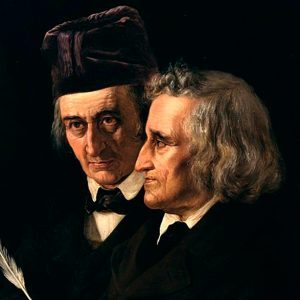 Роль и место в литературе
Роль и место в литературе